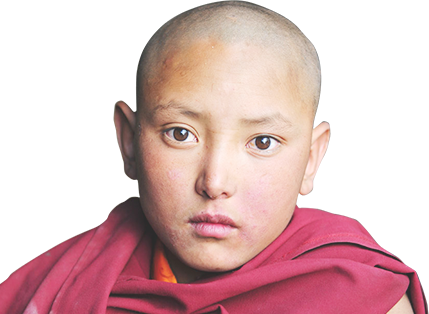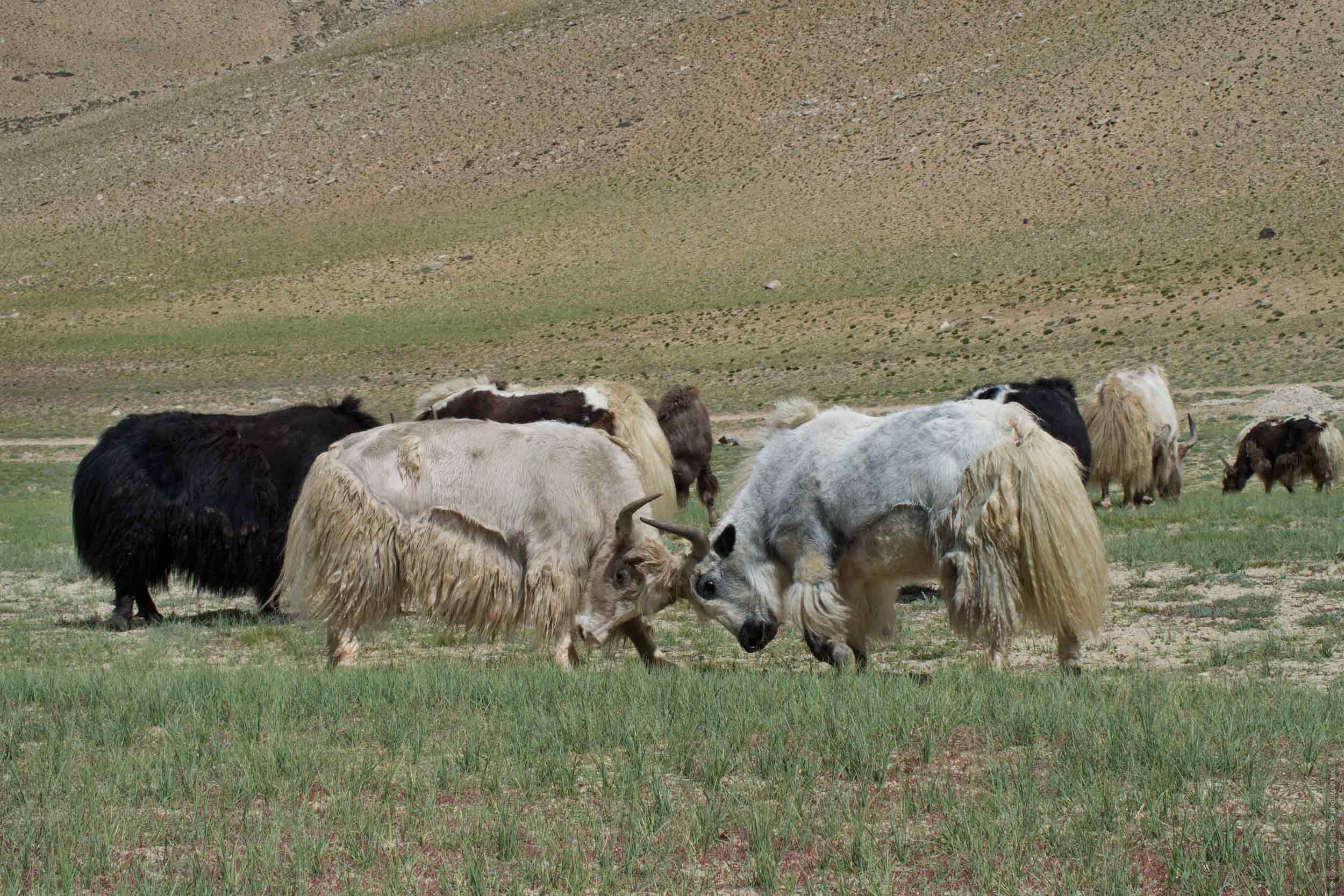The Booking of your participation in any journey takes place in three stages:
First step: Filling the application form for participation in the tour. Be sure to include your full name, We work officially and all accounts are registered. Please write your contact so that we have the communication wit you. After your application come to our website - the site administrator will send you a bill at your name for a advance of the tour. Maximum response time: 6 hours. Usually responsible for 1 hour.
Second stage: The reservation to participate in any tour takes place when you make the advance payment of 30% of the tour price to the account of an Indian travel company INCREDIBLE HIMALAYA. The advance is transferred via bank payment systems in any bank, account details will be sent by the administrator to e-mail of participants after getting the application form for participation.
ATTENTION Booking the tour takes place only when the advance payment transferred. If, after receiving of the invoice for advance payment, you do not make a payment within three working days, your application form for participation is automatically canceled by site. If you still want to participate in the tour, you have to apply the form again. When we receive an advance on our bank account we sent payment receipts confirming your participation, as well as a contract for the provision of travel services on this tour. The administrator sends you the electronic copies of receipts and contracts with digital signature and seal by e-mail and if necessary - to the postal address - the original documents. The remaining amount is payable as ayou arrive at the beginning of the trip, in India.
The third stage: Preparing for the journey. We also have a verbal communication on Skype with members of our travels. 2 weeks before the tour we gather the whole group in Skype and discuss preparations for the journey. Also welcome verbal individual consultations on Skype, it helps us to answer all your questions maximized. Because the most of the year we are in India, the main communication with us is Skype.
Attention! You don't need to register on our site to join the tour. If you are unable to fill the application form, please just send your application in letter (free form) - by mail: [email protected]
Attention! If you have not received a response to your letter within 6 hours (maximum response time for a request), please look at the spam folder. Perhaps, our letter got there by mistake. We always reply to requests in a maximally short period of time.
Female Tour of Ladakh. Adventure from 2 Parts.
Day 1, July 19: Delhi - Leh. Delhi - Leh (air travel). Adaptation day. Walking through Leh.
Day 2, July 20: Leh - the monastery of Tiksey - Hemis village, 50 km.
Day 3, July 21: Hemis village, Hemis monastery. Meeting with a Tibetan doctor.
Day 4, July 22: Hemis village - Newma village - Tso Moriri lake, Karzok, 210 km.
Days 5 - 6, 23 - 24 July: The village of Karzok. Buddhist mystery Karzok Gustor. Lake Tso Moriri. Settlements of nomads ChongPa.
Day 7, July 25: Karzok - Valley of Geysers - Lake Tso Kar - Rupshu Valley - Bordovoye Gorge - Leh, about 287 km.
Day 8, July 26: Leh. Free day. Old city Leh.
Day 9, July 27: Leh - Monastery of Djulichen - village of Domkar, Da Hanu, 158 km.
Day 10, July 28: The village of Domkar. The basics of Tibetan cuisine + picnic with local women. Walks through the village.
Day 11, July 29: Domkar village: one day of the Aryan woman. Tibetan clothes and ornaments.
Day 12, July 30: Village of Domkar - the village of Hanu Ekma - Leh, 250 km.
Day 13, July 31: Buddhist mystery Dak-Tok Tsechu, Dak-Tok monastery. White Stupa of Naropa, 100 km.
Day 14, August 1: Leh-Delhi flight. Homecoming.
Attention!
The cost of the tour with a reservation before January 1, 2020 - 1 352 USD,
The cost of the tour with a reservation after January 1, 2020 - 1 491 USD.
Reservations for participation in the Ladakh Women's Tour are made when the Indian travel company INCREDIBLE HIMALAYA PRIVATE LIMITED is paid in advance in the amount of 140 USD to the settlement account of our Indian travel company.
The advance is transferred by the participant of the tour with the help of payment banking systems in any bank, the details of the settlement account are sent by the administrator to the email of the participant after receiving the application for participation in the trip.
When making an advance payment, the participant is sent a payment receipt and a contract for the provision of travel services, confirming the deposit of money and the reservation of your participation in the tour.
The rest of the amount is paid by the participant upon arrival at the place of the beginning of the tour, in this case - upon arrival in Leh, Ladakh.
1. Transfers from / to the airport to the hotel in Lehi.
2. Movement along the entire route (from the gangway to the gangplank) in comfortable cars.
3. Accommodation in double rooms in hotels, guest houses and camping along the route of the photo tour.
It is possible to stay in a single room, a surcharge of $ 232 for the whole route.
4. Information support by the organizers of the PhotoTour Project from the beginning to the end of the tour.
5. Excursion support of the guides of the PhotoTour Project.
6. Lecture-introduction to the culture of the basic values of Tibetan Buddhism: Wheel of Samsara - instruction for life.
7. Lecture-introduction to the culture of Tibetan Buddhism: mystery with the performance of the Dance of Tsam.
8. Lecture by Kakar Lonpo:
The role and place of a woman in a Tibetan family, The foundations of Tibetan cuisine, Tibetan clothing and ornaments.
9. Practical master classes:
Cooking Tibetan cuisine, Tibetan clothing and decorations, Working with wind resources, Ritual of ignition of the Tibetan oil prayer lamp, Cleaning the house.
10. Individual consultation with the Tibetan herbalist doctor in the village of Khemis, a lecture by the doctor on the basics of a healthy life.
11. Consultation and pulse diagnostics at the Institute of Tibetan Medicine, Men-Dze-Khang.
12. Kite and oil Tibetan lamp.
13. Participation in the Buddhist mysteries Karzok Gustor (Lake Tso Moriri) and Dak Tok Tsechu (Dak Tok village).
14. Picnic with Aryan women in the village of Domkar.
15. One professional portrait in national Aryan clothes and in ornaments in electronic form.
16. All taxes and fees on the route of the photo tour.
1. Flight to Delhi airport from the country of residence and back.
ATTENTION!
Flight from Europe to Delhi and back - very inexpensive:
in May-June these air tickets will cost about $ 300 in both directions.
2. Flight Delhi - Leh - Delhi. The estimated cost of air tickets from $ 80 to $ 120.
Attention!
These air tickets are redeemed immediately after making an advance payment for participating in the trip:
the administrators of PhotoTour Project provide assistance to the tour participants in the purchase of these air tickets at the minimum cost.
It should also be noted that the earlier flights are bought, the cheaper they are.
3. Tourist visa to India $ 100, processed online 7 days before arrival in India.
Information on registration of tourist visa to India.
4. Entrance tickets to the monasteries, about $ 10 for the whole time.
5. The cost of the permissions to the closed border zones of Ladakh (Lake Tso Moriri, the Aryan villages of Da Khan), $ 20 per permit.
6. Meals during the tour: about $ 140 for the entire trip.
7. Medical insurance: it is issued by each participant individually.
8. Mandatory tip to drivers and English-speaking tour guide at a rate of $ 1 per day.
9. Everything that is not listed in the "Included in the tour price list".
Women's Ladakh Tour is designed for ladies from any country in the world.
ATTENTION!
This tour does not have special requirements for physical condition and health.
Do not also worry about high-altitude acclimatization:
we are able to conduct acclimatization and, practically all our tourists, easily transfer the climate and the height of Ladakh.
Tour has age restrictions: from 15 years to 65 years.
ENTRY FOR PARTICIPATION IN THE WOMEN'S TOUR ON LADAKH IS POSSIBLE UPON 10 JUNE 2020.
But the recording in the tour can be stopped earlier - as soon as a group of 10 people is typed.
The number of participants on the tour is fixed.
If you want to go to the Ladakh Tour of Women, please book in advance.
Conditions on the tour as comfortable as possible for Ladakh:
- in Leh: cozy warm hotel with hot water, with bathroom and toilet in the room, wi-fi in the room.
- in the village of Hemis: a new cozy guest house, showers and toilets in every room.
- in the village of Karzok, Lake Tz Moriri: a luxury hotel with a view of the lake, a toilet and a shower in the room, hot water, periodically there is wi-fi in the room.
- in the village Donkar: a new cozy guest house, showers and toilets in each room.
For those who want to ask questions about organizing and participating in the Women's Tour of Ladakh, please contact us:
Phones for communication:
+7 968 007 74 47 (Russia) - Ilona Kryzhanovskaya, Project Manager, PhotoTour, India.
+ 91 94 19 274 735 (India) - Ilona Kryzhanovskaya, Project Manager, PhotoTour, India.
+ 91 95 96 796 372 (WhatsApp, Vacap) - PhotoTour Project, India.
skype:
il-il-il (or search by email [email protected]) - Ilona Kryzhanovskaya, Project Manager, PhotoTour.
Brasilia3090 - Nina Lozenko, Project Director, PhotoTour.
e-mail:
[email protected] - Ilona Kryzhanovskaya, Project Manager, PhotoTour
[email protected] - Nina Lozenko, Project Director PhotoTour
Team of organizers works on the Ladakhu Women's Tour:
Ilona Kryzhanovskaya - Project Manager PhotoTour, ethnographer, psychologist, professional photographer.
Kakar Lonpo is co-owner of the Incredible Himalaya travel company, an expert on ethno-tourism in Ladakh.
Yeshea Lonpo - Ladakh female guide.
Sonam Rinchen is a partner and co-founder of PhotoTour Project.
Otzer Rinchen - head of the team of Project Photo Tour guides.
Nina Lozenko - Director-Administrator of the PhotoTour Project.
Our local Ladakh English-speaking culture guides, PhotoTour Project team.
A team of driver guides along the whole photo tour route.
For participants of the Women's Tour in Ladakh, we recommend to read,
Here there are answers to all questions regarding the conditions of the tour and preparation for it:
Recommendations and rules for photo travelers and travelers on Ladakh, Zanskar and Spiti Valley (Small Tibet).
Tour guides Kakar Lonpo and Ilona Kryzhanovskaya.
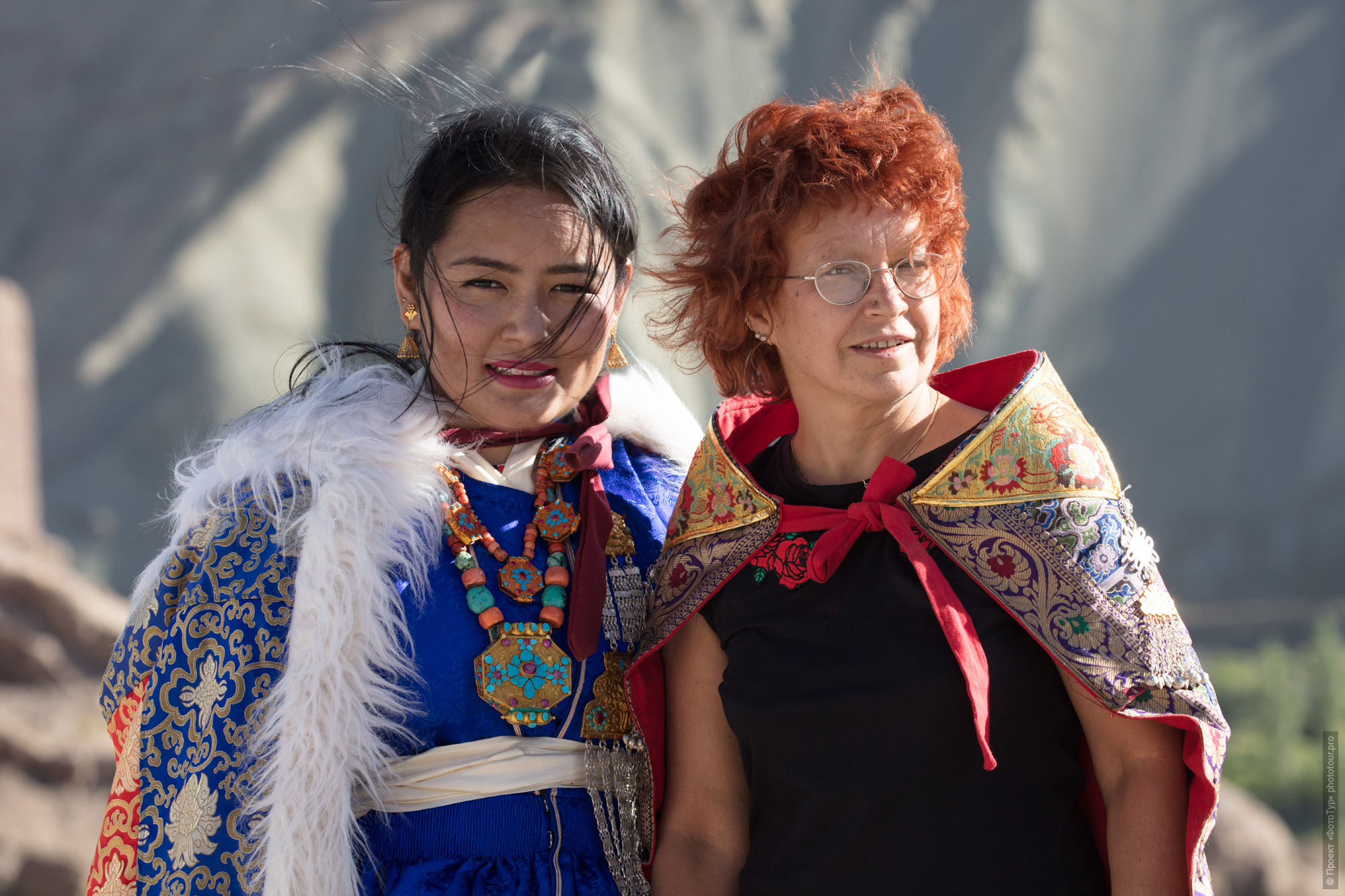
From Ilona Kryzhanovskaya:
This is a journey of Love.
Long thought how to announce this tour, advertising phrases - do not want to, it was painfully long and in detail this program was born, you can say you have suffered.
Next year will be my 10th season in Small Tibet, I've been here since 2009.
And these years, spent in the lands of the promised, have changed me greatly.
No, it was not Buddhist practices, not teachings, not puja in monasteries, not communication with lamas that changed me, although - yes, they certainly imposed a proper imprint.
I was changed by ordinary everyday life among ladakhi, communication in my Ladakh family, communication in family of friends.
It's very similar to how you fall into the field with completely different vibrations - and gradually you start to vibrate-sound the same.
It was a long road of change - the culture of Ladakh (formerly Western Tibet) is very different from Europe.
This road continues to go, and now.
Why tour female?
Because it's really made for women:
I want to share the experience of the centuries-old culture of the soft Ladakh matriarchy, in which women in the conditions of a heavy mountainous landscape are exactly Women, just like the Great Letter, in every sense of the word.
Just the facts:
- in Ladakh there are no divorces, well, not from the word "absolutely", weddings are played very consciously once and for life,
- there are no unmarried women in Ladakh, there are widows, but they also often marry,
- in Ladakh women are happy in their families, and even if difficult times come they can quickly get out of any negative situations, here the norm is a calm and mildly happy family condition,
_ In Ladakh, husband and wife manage to be all their lives not only spouses, but also close friends - this is the natural norm of life,
- in Ladakh do not drink alcohol, only chang (Tibetan vodka) and that in scanty medicinal purposes,
- in Ladakh, a woman identifies, creates a man - it's awesome, incredible - I, by the way, am watching this last year in the family of my close friends - on September 23, 2016, Sonam married Kakar when I saw him the next year - honestly - stunned: smart, healthy, bad habits - oh, zero, business abruptly advanced, the energy of the sea, I still thought - what resource did Kakar give him,
- in Ladakh, by the way, there are no orphanages and orphans, and about abortions here in general are not very well aware,
- In Ladakh, women who do not have hot water, boutiques, SPA-parlors and gyms are absent in the house, as well as manicure pedicures, etc., the altitude is 3600 m in Leh, further higher, nomads generally live in tents all the year round , and so, without this all - the women here are very beautiful.
- in Ladakh a very different old age: 90-year-old grandmothers climb into haystacks with hay in autumn and famously taunt them, throwing hay with pitchforks. But the main thing is not even that - they remain curious - they are really interested in who I am and where from.
- in Ladakh very friendly: there is a smile - the norm, the natural norm of life,
- and most importantly - in the hardest conditions of the highlands of Ladakh, in houses where there is no centralized heating, metal-plastic windows (then you can list the other blessings of civilization - they are also not here) - women are really healthy, very active and happy in their families and are engaged in, that they really like,
- By the way, they are not very familiar with the word "depression", and at first I was not too understood when I tried to share some or other of my sufferings, including about the relationship. But they always listened attentively, although in surprise, over time, I began to wonder at my reasons for suffering, and then they somehow began to disappear, dissolve.
- and most importantly - in Ladakh women are filled with ENERGY, full of it to the brim, there is no state of chronic fatigue - I did not see, I got tired from work - yes, normal, but restoring during sleep - instant, this is a completely different state of life, in fact is like a parallel world. And they are very natural in all their manifestations.
HOW DOES THE LADAKH WOMAN KEEP IT?
That's it about this our journey.
And more - you can read in the program of the tour, there every day is painted in great detail and filled to the brim with all sorts of practices - lectures - mystery events.
What you need to know about this tour:
there are no similar trips in principle - it's me and Kakar came up with.
Most of the tour will take place in local villages, where tourists do not happen.
But the living conditions will be comfortable, and the food - healthy and very tasty - do not be afraid).
P.S. We are doing this tour for the second time. For the first time the tour took place in the summer of 2018.
P.P.S. We are asked by male photographers: can they take part in this tour?
Probably, yes, they can - if the program is interesting).
All the photos shown in the tour description were taken by us during our travels along Ladakh and these are the places you will really see and where you will visit taking into account the schedule of the tour, weather, etc.
The photo is clickable to a large size, just click on the photo and it will open in a new window.
In the description of each day of the tour, the heading gives an approximate kilometer for each day and the heights of the places visited.
Before going to a detailed description of each day of our tour, I want to say two things:
1. Ladakh, Lesser Tibet is the only territory on our plan where the ancient culture of Tibetan Buddhism was preserved in its original form.
Here everything is really preserved in its original form:
and the female role, as in the old days, remains the leading one in society, in fact it is a territory of soft matriarchy.
It is a centuries-old culture with the cult of Tara, the Savior of the World, born of the tears of Avalokiteshvara (Buddha of Compassion), at a time when he mourned the suffering of the world.
From the fallen tear rose a lotus, and from him was born Tara, who became his wife.
This metaphor reflects the actual way of life and the role of women in the culture of Ladakh.
And European women have something to take from the attitude, the perception of peace and life of a Tibetan woman, this knowledge really enriches and makes life, relations with men completely different, different level.
2. And Ladakh is simply a stunningly beautiful, atmospheric place.
And these are very strong places for energy:
it is not by chance that scholars and esotericists of all times have sought this.
I want to show this atmosphere of those places on which our tour is taking place and we will do it with the help of a small amateur film shot by our friend and tourist Sergei Pobegaev in 2014 during a tour of high-mountain lakes:
Sergey Pobegaev: LADAKH.
And now - a detailed schedule of our tour.
Day 1, July 19: Delhi - Leh. Delhi - Leh (air travel). Adaptation day. Acclimatization. Walking through Leh.
Arrival at New Delhi International Airport (India) from the country of residence.
We issue an electronic visa, get the luggage and go to one of the terminals of local airlines:
D3 is in the same building
D2 - a little further, you have to turn left from the terminal building of international airlines and walk 100 m through the tunnel.
This is a common practice on our Ladakh tours:
Flights on which members of our tours arrive at Delhi Airport usually arrive at terminal D3 from 2 to 5 am, immediately go to the departure terminal and fly to Leh on one of the morning flights.
Flights for Delhi - Leh take, so that the time margin between the external and internal flights is 3-4 hours.
Flight Delhi-Leh, 1 hour 20 minutes.
By the way, the flight Leh-Delhi is a stunningly beautiful sight, since we will fly on the Himalayan Range.
We recommend that you reserve in advance on the left side of the aircraft - when landing in Leh, this side is the most filming.
The Delhi-Leh air flight itself is an exciting sight - it's impossible to tear yourself away, the plane flies over the most beautiful peaks of the Himalayas.
For those who want to take pictures of mountain ranges from an airplane, the most suitable seats are from 25F to 30F and from 25A to 30A.
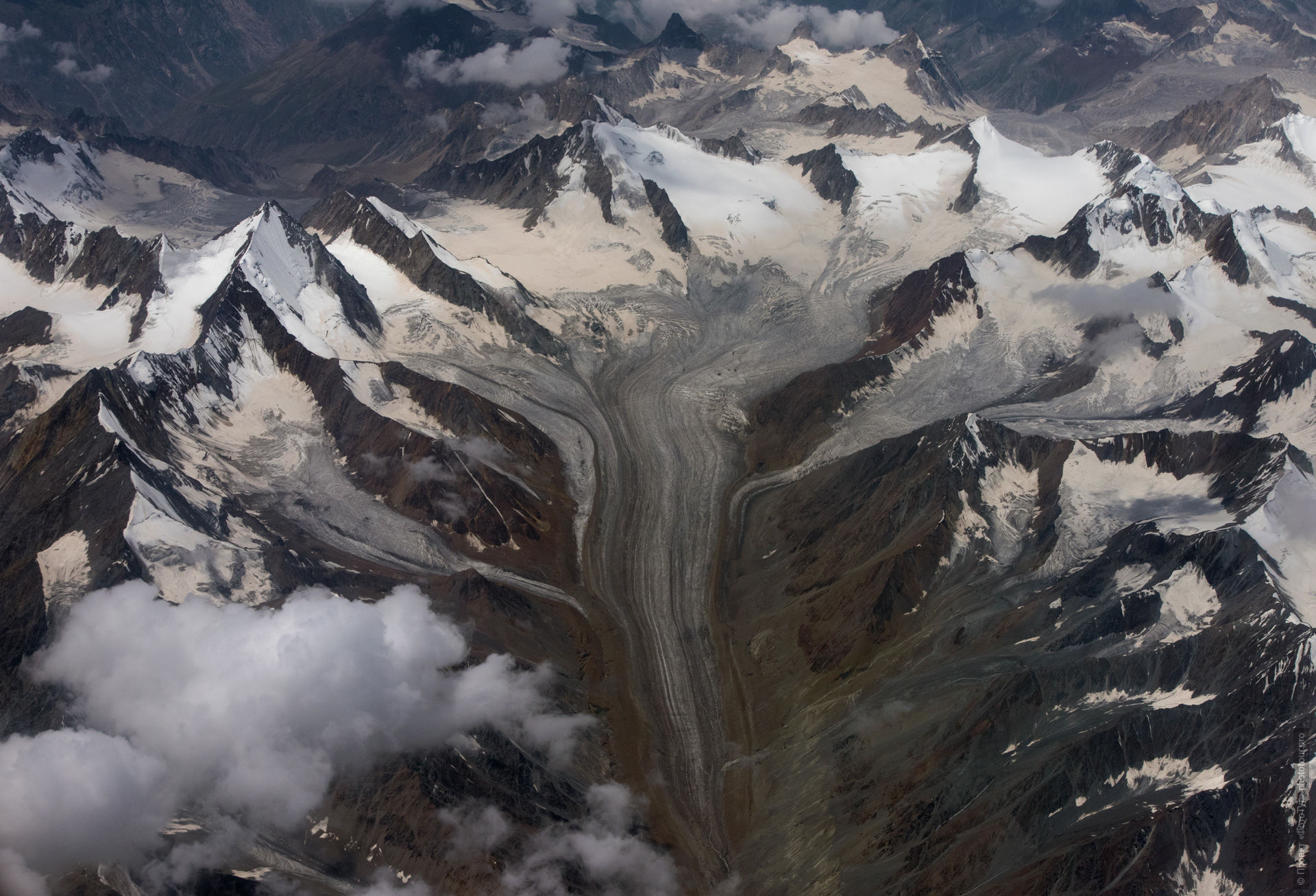
The plane literally sneaks, moves along the gorge in the middle of the mountain chains, the mountain ridges are pictures below.
You will see massive glaciers, deep mountain valleys, turquoise river belts, lakes, a multicolored high-altitude desert with threads of the Leh-Manal highway - all those places we will visit during our trip.
A lot of things you will see, but it is very important - to book a place in advance near the porthole:
when registering at the airport such places will no longer be.
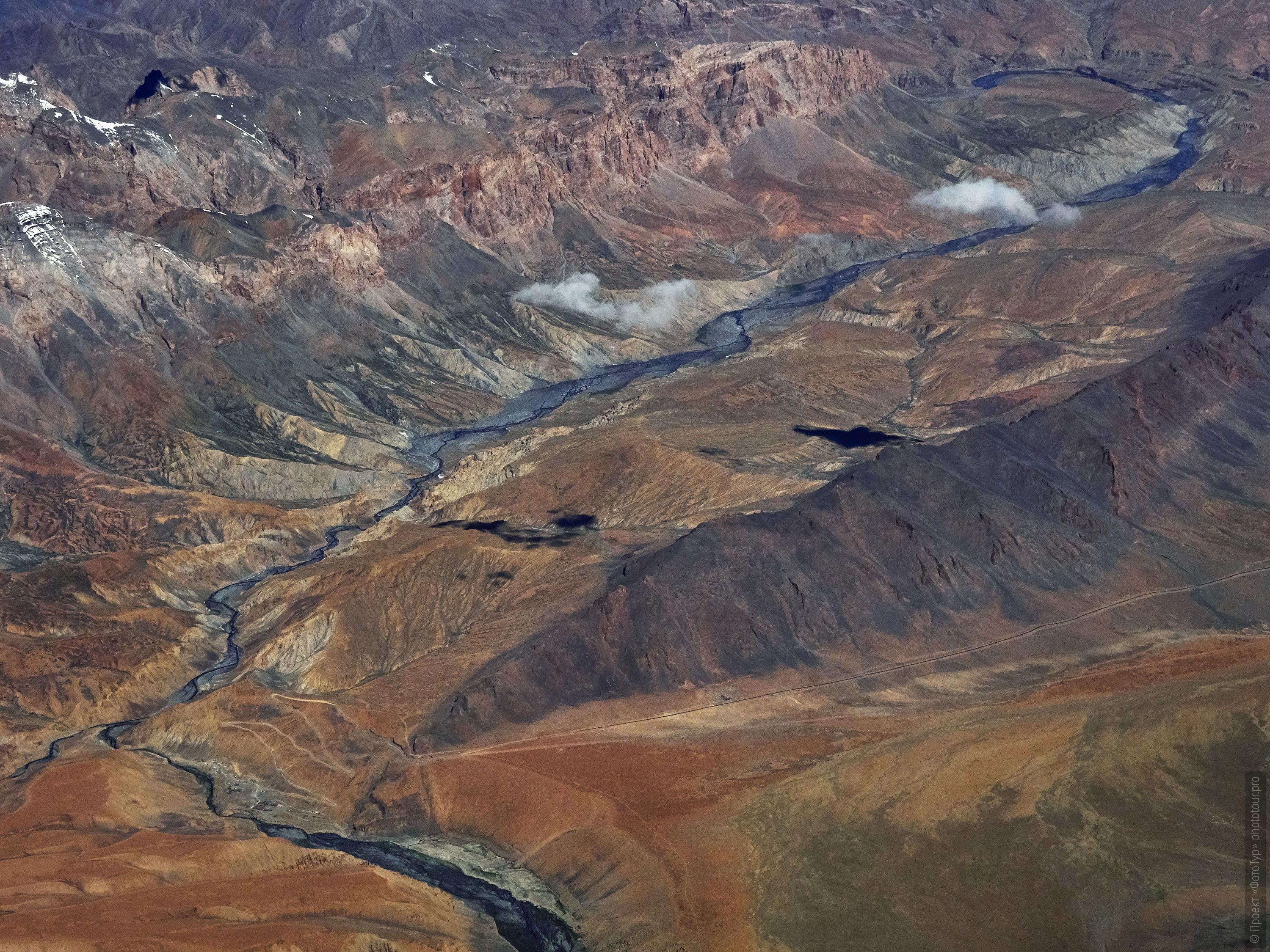
We fly to Ladakh, the plane makes a beautiful turn over the valley of the river Indus and lands at the only airport in the valley - in Leh.
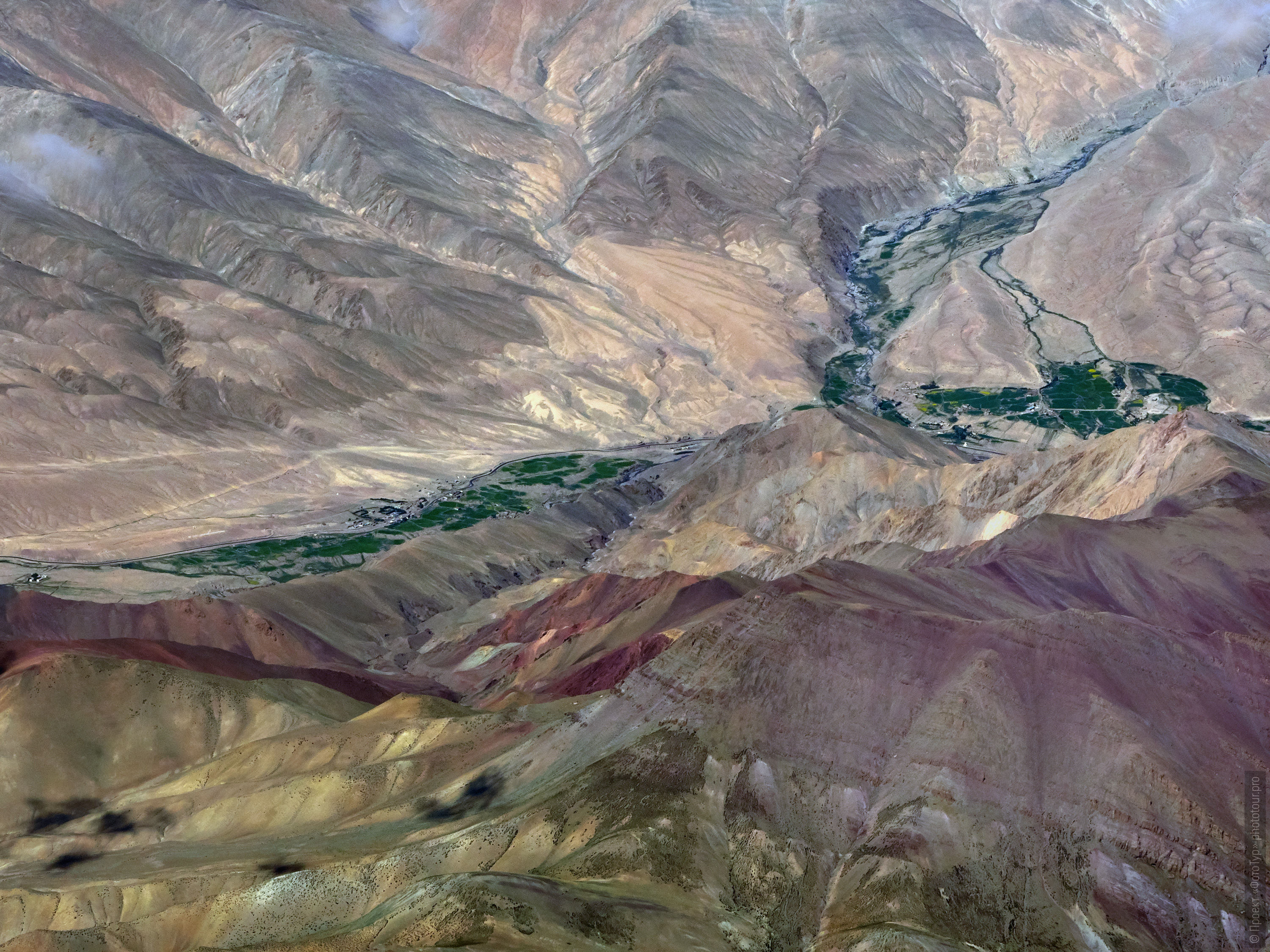
Transfer to the hotel, breakfast.
Leh is at an altitude of 3600 m.
And on the first day of the tour it is very important for participants to undergo the correct altitude acclimatization:
we pass the instruction on acclimatization, drink a lot of liquid, the first hours on arrival we rest in the hotel.
After acclimatization rest in the hotel we go on a leisurely adaptive walk to the center of Leh on Main Market:
get acquainted with the infrastructure of the city, walk along the main street of the city.

We'll finish our walk in the wonderful café-restaurant Penguin, where our first dinner in Leh will take place.
Hotel in Leh.
The First Part of the Ladakh Adventure: A Great Cleansing. Sources of Women's Power.
Day 2, July 20: Leh - the monastery of Tiksey - Hemis village, 50 km.
The heights of the day Leh (3600 m) - Hemis (3,700 m).
In the morning we go to Buddhist monastery Tiksey Gonpa.
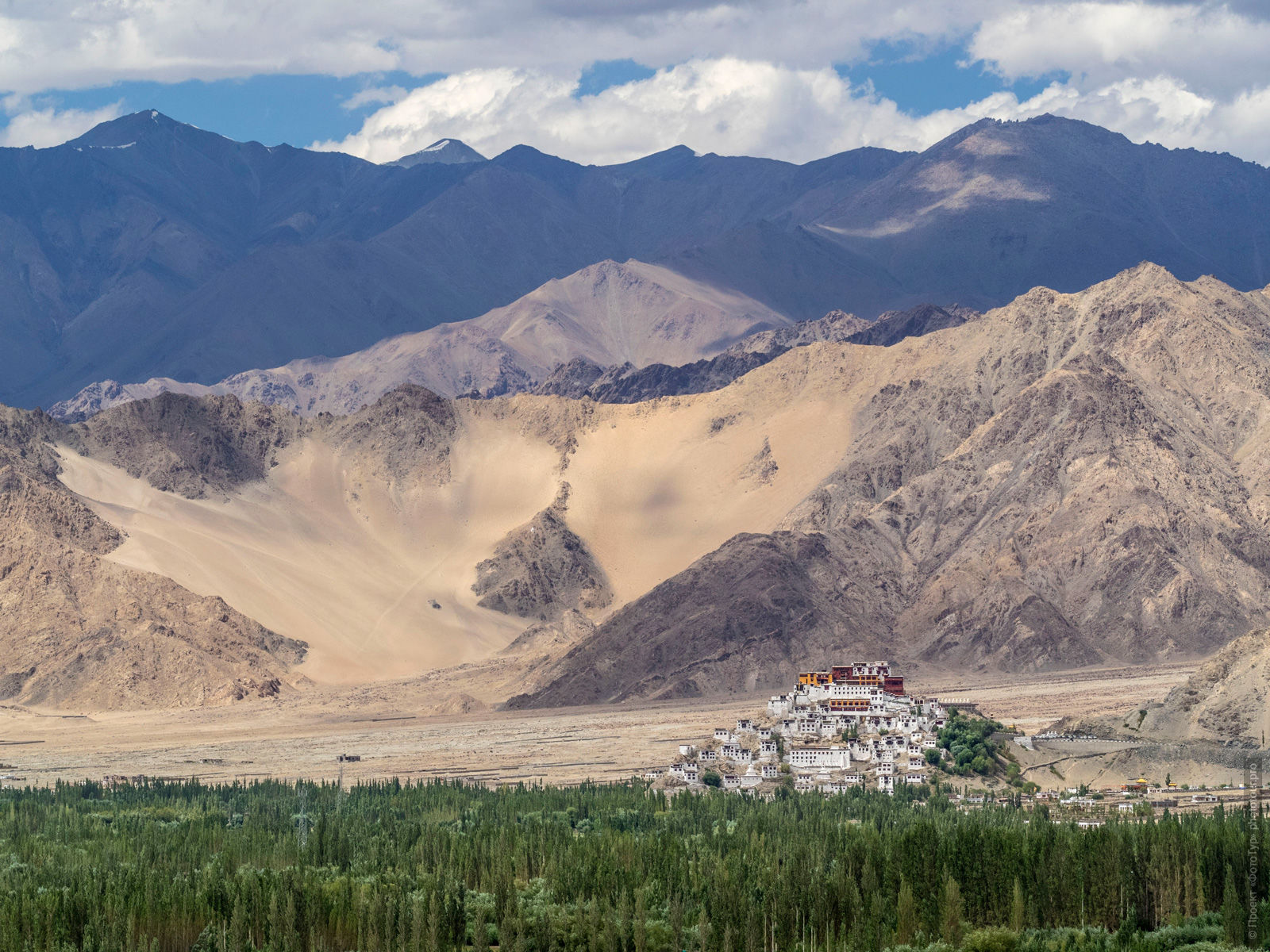
The monastery itself is huge - the largest in Ladakh, in fact a monastery town, with surrounding villages, surrounded by ancient stupas, lamas houses, monastic schools.
The monastery of Tibsey Gonpa consists of twelve levels and ten temples that rise on the slopes of the mountain.
At the very top are private apartments Rinpoche Gonpa.
Below the monastery itself, along the mountain slopes, there are chapels and houses of monks.
Walls of Tyxeus Gonpes are covered with amazing ancient frescoes, for example, with scenes of sacrifices.
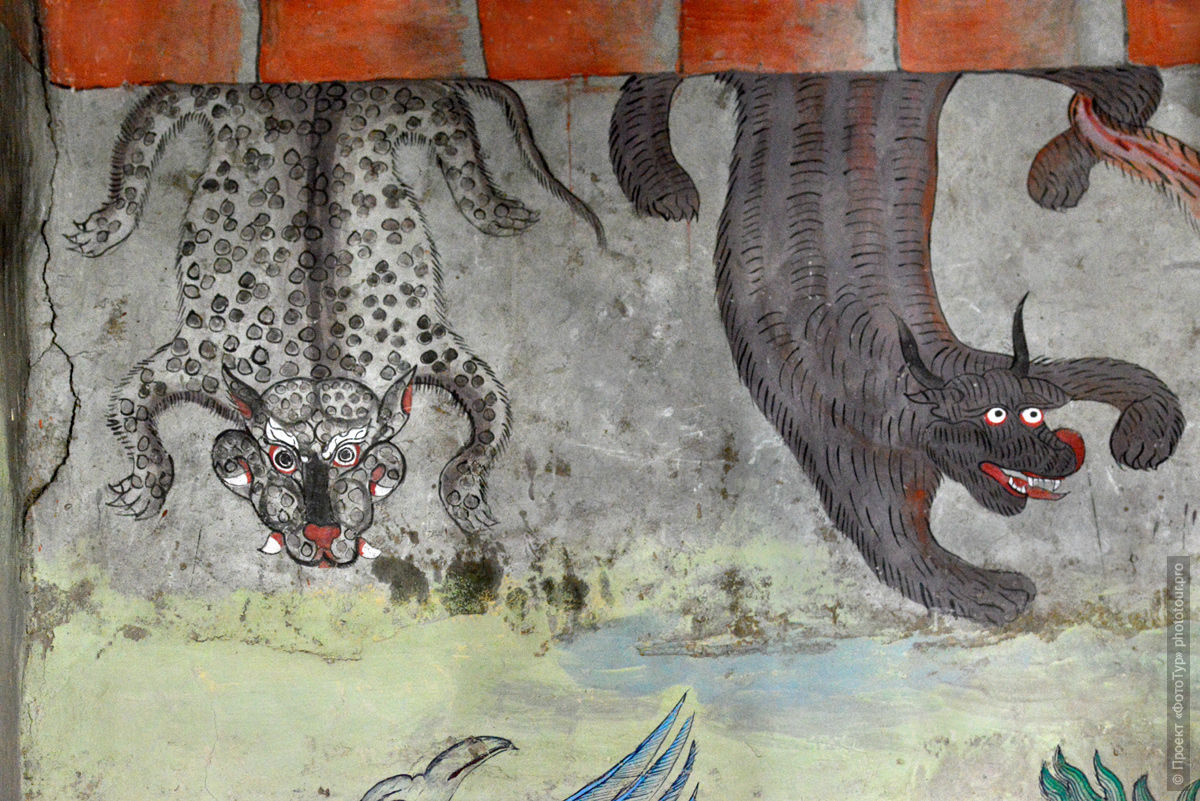
We visit the monastery will be interesting for two reasons:
1. Here, for the first time, we will see the Wheel of Samsara - essentially instruction to life in the culture of Tibetan Buddhism and we will try to thoroughly understand this instruction:

2. We will also visit the Tiksey Gonpa nunnery and get acquainted with the life of the Nanari Ladakh women who took monastic vows.
Transfer to the village of Hemis.
We come to the native village of Kakar Lonpo, here she was born, her childhood was here, here her parents' house:
and that's why the doors of all the houses will be open to us and will be able to enter each house without hindrance.
Walking around the village, getting to know the life and lifestyle of Ladakh women in the village of Khemis.
In the evening, a lecture by Kakar Lonpo and Ilona Kryzhanovskaya about the life of Tibetan women in the family.
The following topics will be touched upon and not theoretical, but how it really happens in real life in Ladakh:
- attitudes in the Tibetan family;
- Sex, menstruation, childbirth;
- mild matriarchy and polyandry (much courage) in the territory of Lesser Tibet;
- Tara: Tibetan mythology in the real life of Ladakh women.
Guest house in the village of Hemis.
Day 3, July 21: Hemis village, Hemis monastery.
The height is 3 700 m.
In the morning we walk from the village to Hemis Gonpa, a Buddhist monastery, for the morning puja (monastic service).
The monastery is in the immediate vicinity of the village and we just have to go down to the monastery along the picturesque trail.
Buddhist monastery Hemis Gonpa is the largest and richest monastery in Ladakh.
It was founded in 1630 by the first incarnation of Stagsang Raspa by Navang Gyatso.
There are also versions that in the 17th century the monastery only received the kind that it has today, and it was built in the 11th century, although it has since transferred a lot of redevelopment.
Therefore, Hemis Gompa is also considered one of the oldest monasteries in Ladakh.
The monastery is very iconic - the story is as follows:
Naropa meets Tilopa.
Tilopa - the greatest tantric master - gives Naropa 12 "great" and 12 "small" tasks for the manifestation of emptiness and illusoryness of all things.
Naropa is named "rector of Nalanda," a monastery university in today's Bihar, India, which flourished before the Muslim invasion.
Perhaps the wars in North India prompted Naropa to go to Ladakh.
Tilopa and Naropa met in Chemis and went to the now-extinct kingdom of Maghad, called Otantra, and is now identified with Odantapuri (Bihar).
Thus, Naropa created the Kagyu school, and Hemis became the birthplace of this school.
Переводчик Google для бизнеса –Инструменты переводчикаПереводчик сайтов

In the monastery, beautiful ancient wall paintings were preserved and restored.
Including we will visit and Gonpa 21 incarnations of the Mother of Tara:
this is a small quiet monastery, very calm, but the sensations inside are fantastic.
For lunch we return to the village.
After lunch, in the second part of the day, an individual reception at the Tibetan herbalist with individual recommendations.
After receiving a doctor's lecture on the topic:
"Beauty, natural cosmetics, recommendations for healthy eating."
And already in the evening, after dinner - the first lesson on Tibetan energy practices:
Purifying breath.
Guest house in the village of Khemis.
Day 4, July 22: Hemis village - Newma village - Tso Moriri lake, Karzok, 210 km.
The heights of the day: Hemis (3,700 m) - Newma (4,000 m) - Karzok (4,400 m).
Today we set out on a long and rich road, now upstream of the Indus River.
In general, that's what, and impressions and emotions in Ladakh are always incredibly many.
On the way, we will go to a completely non-tourist place - the village of Newma, which is located near the Ladakh Observatory.
Visiting the Buddhist monastery of Newma, puja for members of the group.
Today we are waiting for a meeting with the high-mountain lake Tso Moriri, we will have a beautiful and long road with stops:
nature here is so beautiful that it is impossible not to stop at least for a while.
In one of these stops we will have a picnic lunch in the nature of the river Indus, for example, here in this place.
We'll have a picnic with music and dancing.
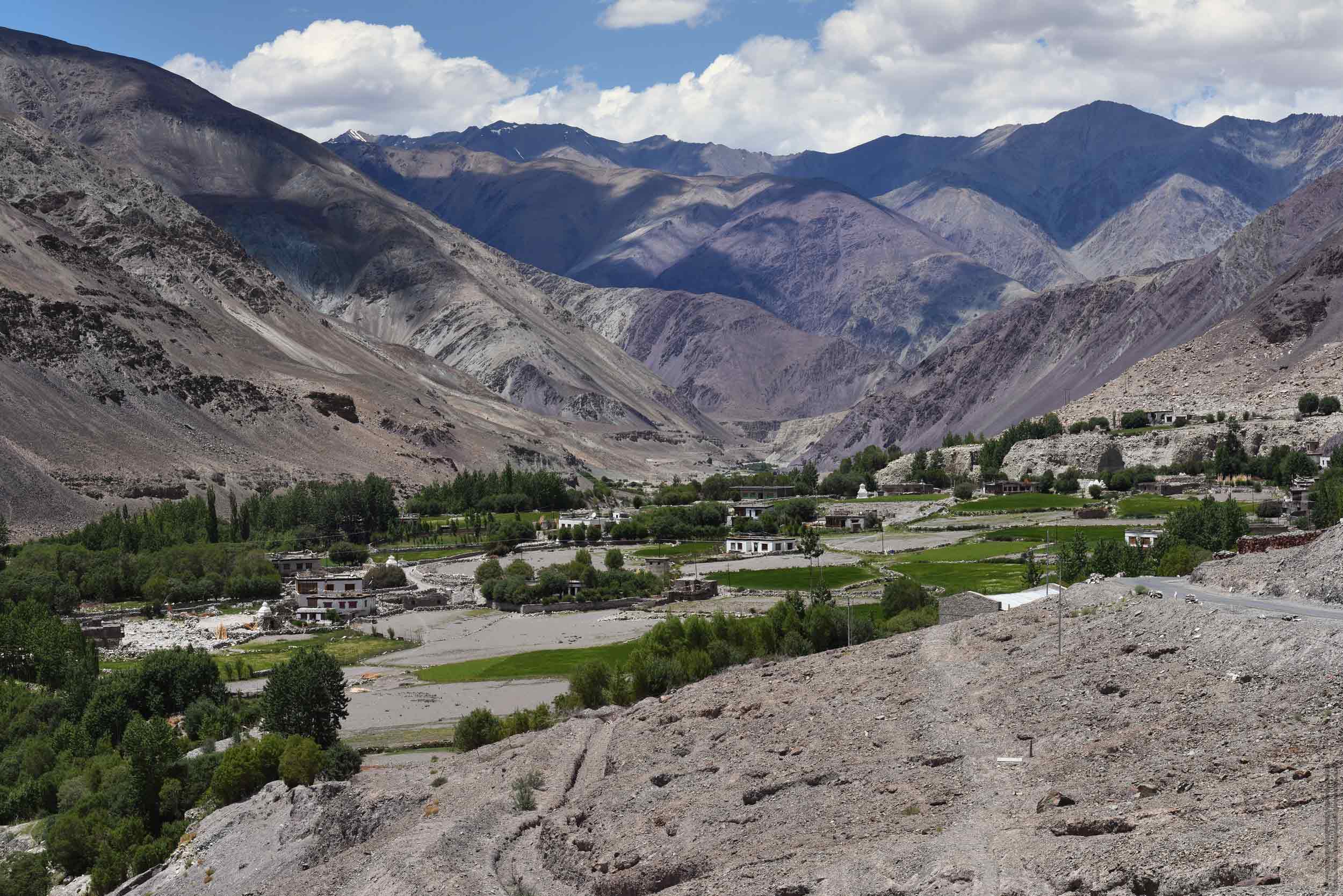
Further we will cross the Yalung Nyalung pass (5450 m) and the dusty Rupshu plateau.
From the pass we will see a view of Lake Kyagar Tso (Kyagar Tso), an uncontrollably blue color, like the precious eye of aquamarine in the rim of the brown shores.

And after another 17 kilometers - a long-awaited meeting with Lake Tso Moriri.
Tso Moriri, Tsomoriri, Tso Moriri is the largest highland lake of Indian Tibet, 215 km southeast of Leh at an altitude of 4,595 m above sea level.
The maximum length of the lake is 19 km, the maximum width is 3 km, the maximum depth is 40 m.
This is the largest high mountain lake in the trans-Himalayan region within India.
The water in the lake is slightly salty. The lake is only available in the summer season.
Until 1959, local residents were engaged in the extraction of salt (czokar, in the local language of Ladakh) from the lake.
On the shore of the lake is the Monastery of Karzok Gompa and the village of Karzok with the same name, where we are heading.

Lake Tso Moriri is a beautiful remote quiet place.
In windless weather, Tz Moriri shakes her mirrors:
the world really becomes double, dual and this duality of the surrounding reality is felt literally physically.
Sunset evening mirrors on Tso Moriri are simply delightful.
Tso Moriri is the most beautiful of the Ladakh lakes.

Evening walk along the lake Tso Moriri:
on the far shore of the lake we hang Buddhist prayer flags and build on a small stupa -
they say that if you make a wish, it will come true.
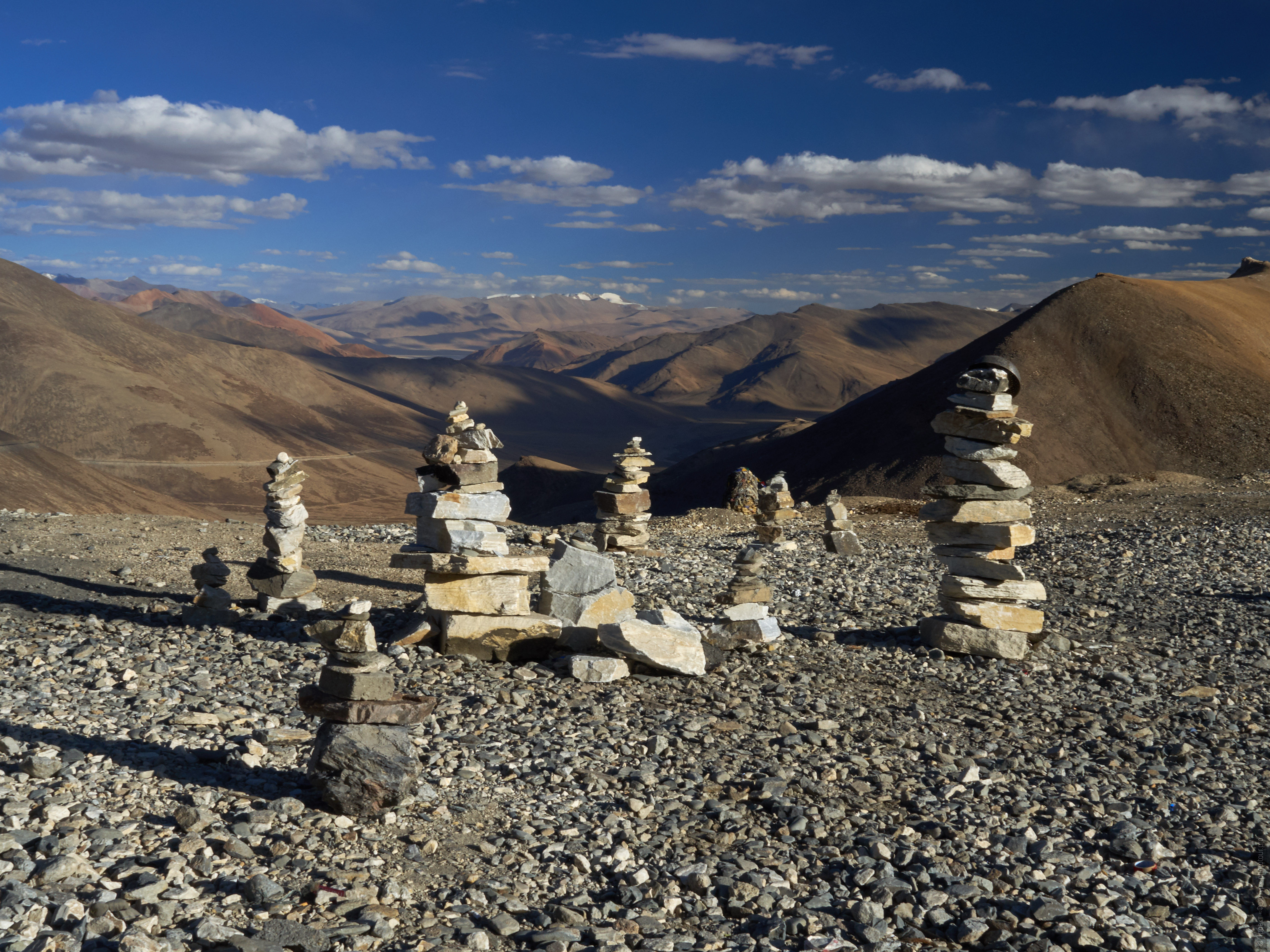
Hotel in the village of Karzok.
Days 5 - 6, 23 - 24 July: The village of Karzok. Buddhist mystery Karzok Gustor. Lake Tso Moriri. Settlements of nomads ChongPa.
The height is 4 400 m.
The next 2 days in the morning we are present at the Korzok Gustor Buddhist festival in Korzok monastery.
Immediately and on the main:
Any Buddhist mystery with the performance of the Dance of Tsam is NOT a theatrical action!!!
This is a very strong mystical energy process, rooted in the deep past.
And, probably, one of the most honest and effective for today.
In a nutshell, the essence of the mystery is this:
in a certain period (once a year) the llamas invite the defenders of Buddhism to clean the territories adjacent to the monastery and all who are on them from negative karma.
During the Buddhist mystery, the monks wear the formidable masks of Dharmapal (defenders of Buddhism), and the deities of the patrons of Tibetan Buddhism, and in fact give their defenders their bodies.
any Dance of Tsam takes place in continuous meditation, often lamas dance with their eyes closed.
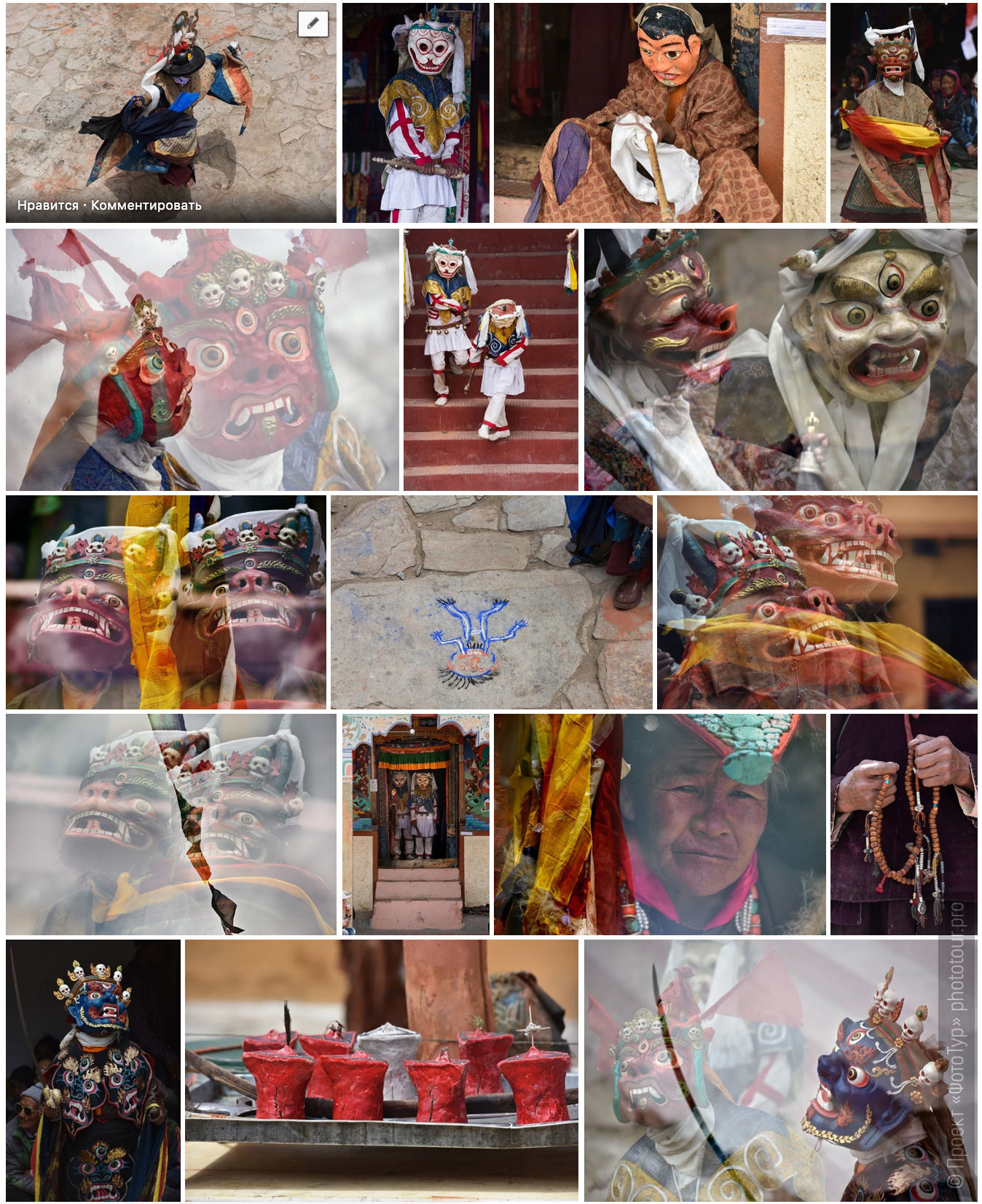
The presence on the Buddhist mystery is the possibility of a global cleansing of one's own life, including at many levels.
This film was shot by us in 2012 on the Buddhist mystery of Karzok Gustor, but it reflects only a small fraction of what is happening these days in Karzok.
We will see the festive processions of Buddhist monks, we will be in close proximity to the mystical Dance Tsam - the sacred dance of Lam in ritual masks, we will witness the sacrifices.
Buddhist mystery Korzok Gustor is held in a monastery and also attracts a lot of Changpa, nomadic Tibetans - these are people's types from almost a deep past, in national clothes, and most importantly - living realities of living Tibetan Buddhism.
These are amazing women - in national clothes, in heavy Tibetan ornaments of turquoise, silver, coral, calmly moving in all this beauty at an altitude of 4600 m.
Buddhist monastery Korzok Gonpa, also called Karzok or Kurzok, is a Tibetan Buddhist gompa belonging to the Drukpa Kagyu school and an ancient village on the shores of Lhamo Lazo.
In Korzok, at an altitude of 4,595 m, there is a statue of Buddha Shakyamuni and about 35 monks.
Previously, the monastery was the center of the Rupshu Valley. As a Drukpinsky monastery, he submitted to the monastery of Khemis Gompa. The monastery is more than 300 years old.
The local population believes that both the monastery and Tzomorari are both sacred places.
By the way, these days at four o'clock in the morning, those who wish can attend the morning puja (service) in the Buddhist monastery of Karzok Gonpa.
During the days of the mystery of the puja, it would take almost 24 hours to go to the monastery.
The final day of the festival ends with the cutting of the corm (sacrificial cake) by the head of the dancers wearing black masks during the 'argham' (killing) dance.
The action symbolizes the destruction of evil.
And it's impossible not to feel, even the surrounding nature actively reacts to the action:
for example, in 2017 at this time of the festival over the village a real hurricane has risen:
the wind, the wind poured from the mountains in an instant, twisted the calm mirror of Cho Moriri, rain, nature as a dumped, accumulated tension.
And then, later in the evening, there was a calm silence.
And what is above Cho Moriri the sky is a separate song:
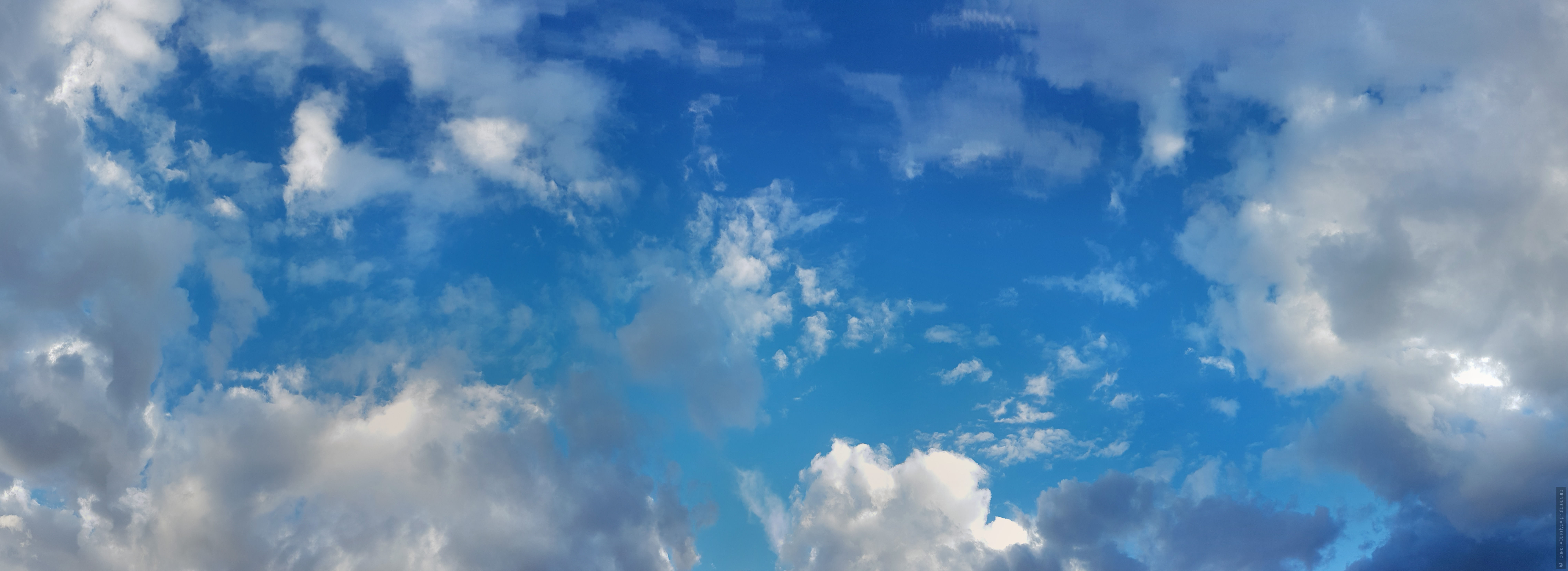
What else will we do in these two days, in the afternoon after the Dance of Tsam:
(we describe briefly, so that much turned out to be a pleasant surprise):
1. Communication with the resource of Fire, again - a solid practice, mastering the ritual of offering Fire and cleaning the house with Tibetan oil lamps.
2. Visiting the local houses of Karzok village - our friends, acquaintance with life and life of women at an altitude of 4600 m.
3. Visiting the Korzok gorge of Fu - summer pasture of the shepherds Chongpa from Korzok, acquaintance with the life and life of women-nomads.
Let's see, by the way, how they milk the huge yaks, and take care of the little ones.
The gorge itself is incredibly beautiful, in a literal sense - mountains of pink and sandy-yellow hues, only this is worth seeing:

During the mystery of Karzok Gustor, many nomads flock to this protected from the winds valley and form a huge temporary settlement - herds, nomadic families fill most of the valley,
the most interesting - yaks, huge, shaggy:
Hotel in the village of Karzok.
Day 7, July 25: Karzok - Valley of Geysers - Lake Tso Kar - Rupshu Valley - Bordovoye Gorge - Leh, about 287 km.
The heights of the day: Karzok (4,400 m) - the Valley of Geysers (4,500 m) - Tso Kar (4,600 m) - Bordovoe Gorge (4,000 m) - Leh (3,600 m).
A very early ascent, and today we return to Leh, but we return quite another road - through the lake of Tso Kar and the valley of high mountain hot geysers.
A very busy day is to come today - we will see so many incredible places and landscapes within 14 hours.
So:
1. Only 17 km from the lake Tso Moriri there is a small beautiful Kyagar Tso lake.
Our first stop on this day is here.
If we are lucky, a herd of horses will wander on the shore of the lake, usually on these festive days the nomads drive their horses here.
Or yaki, if you're lucky.
A short walk along the shore of the lake.

2. Valley of high-altitude hot geysers.
Yes, it is on the road from Tso Moriri to Tso Car that we will visit the unique high-mountain valley of geysers, located at an altitude of about 4500 m.

Geysers here are very different: from small-gurgling huge bubbles to incandescent fountains-geysers with a height of more than three meters.
The Valley of Geysers in the literal sense of the word is absolutely fabulous place:
Here the climate changes sharply under the influence of hot springs and in the middle of the alpine desert of Ladakh there suddenly appear green alpine meadows interspersed with salt marshes, the slopes acquire the brightest colors.
Yellow - yields of crystalline sulfur, among which are hidden transparent ammonium crystals, brown, green crusts of salts.
What's there just is not:
white herons, which in huge numbers live on the banks of the valley, small gurgling springs - very texture photographs are obtained, and, naturally, geysers-fountains.
In the sources you can also swim, and not only you can, but the springs are considered healing, so do not forget to take with you to the tour bathing suits.
The geysers themselves give beautiful bright pictures - pictures.

3. Lake Tso Kar. The most charming and ever-changing of the Ladakh lakes.
Lake Tso Kar is a very strange place:
it is impossible to fix reality - everything is continuously changing, reality here in the literal sense of this word has the property of fluidity.
The clouds are flowing in the sky, the illumination is continuously changing, and with it the color of the lake, the reflections, the color of the coastal deposits are salt, the salts are colored here.
And even a small vegetation - mosses, we will see flowering mosses - also not to catch, to fix the shade.
On Tso Kara it is strange - it's strange and different - it's strange - the lake is too alive, it's difficult to perceive it as a lake, it's some huge living organism.
And still - staying at Tso Kare - is like a continuous leisurely conversation with the lake.

Purely externally - yes, many very unusual places with salt crusts on the banks, is impressive.
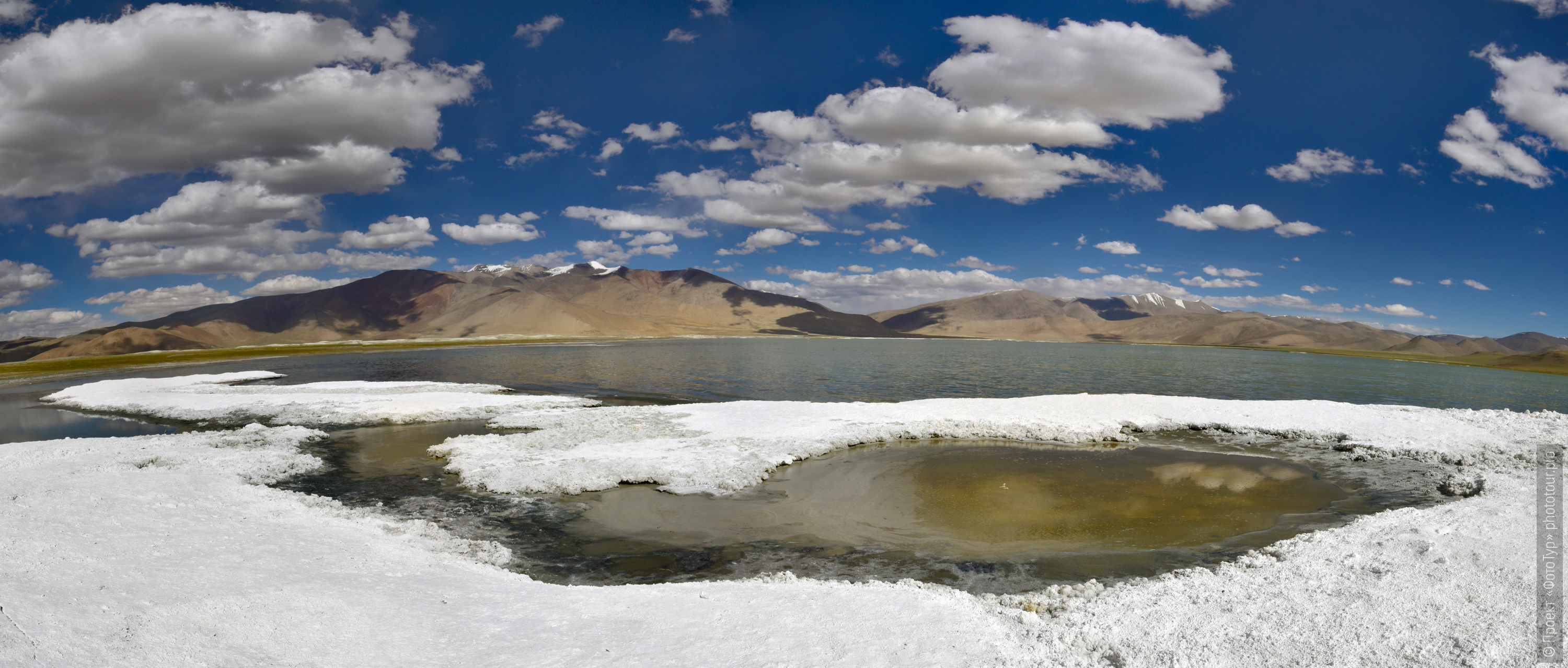
If you're lucky - we'll meet with the inhabitants of Tso Kara, for example, with numerous here, high-mountain wild horses - and maybe we pursue the herd by car:
they like to run a race.

It is worth noting that animals in Ladakh are approaching close enough to themselves:
in Tibetan culture, it is not customary to harm living suffering beings, and as a consequence, creatures here are very open to communication.
4. The dusty valley of Rupshu.
After Tso Kara, through the dusty valley of Rupsh, we will continue our journey to Leh.
Ripshu is impressive - huge spaces, incredible power of the mountain and in the midst of all this beauty - rage-rustle dusty columns of vortexes.
5. Tanglang La Pass, the second highest road in the world in height.
We will ascend to the second highest pass in Ladakh - Tanglang La (5358 m), and from the height we will see the high-mountainous dusty Rupshu Valley, through which only passed.
Here the words are absolutely superfluous, the pictures in both directions of the pass open, yes just so - open.
Here, for example, a view of the Ladakh valley from the Tanglung La Pass.
But on this road we will go down.
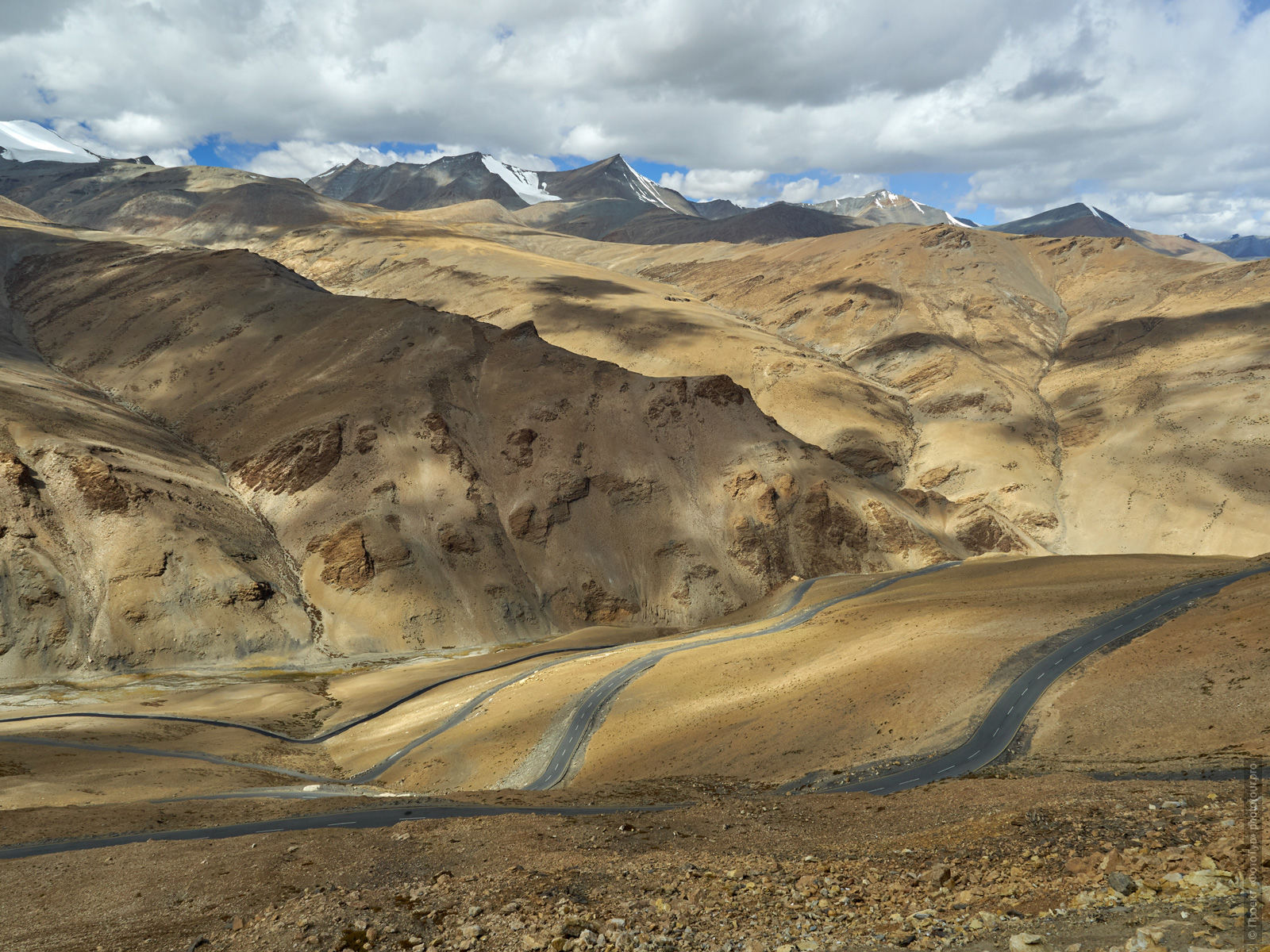
6. Closer to the evening we go down to a height of about 4 000 to the Bordovy Gorge.
The place here is very atmospheric:
The mountains here stood on their hind legs - and five in the truest sense of the word:
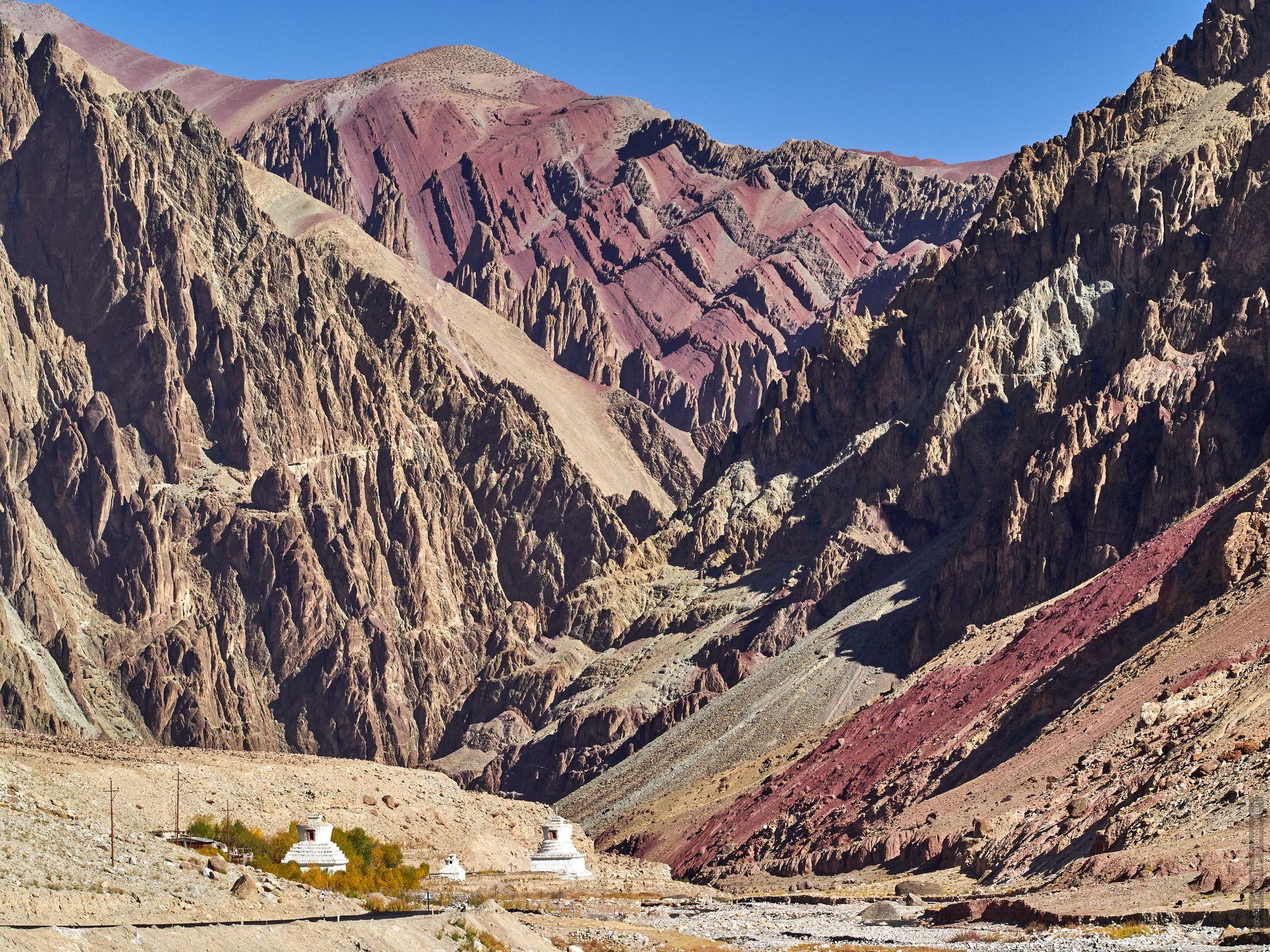
Plowing upwards, curved into incredible folds, rock layers, real stone mushrooms among all this luxuries.
And in the middle of all this - white Buddhist stupas, a monastery in the rocks, the village of Rumce.
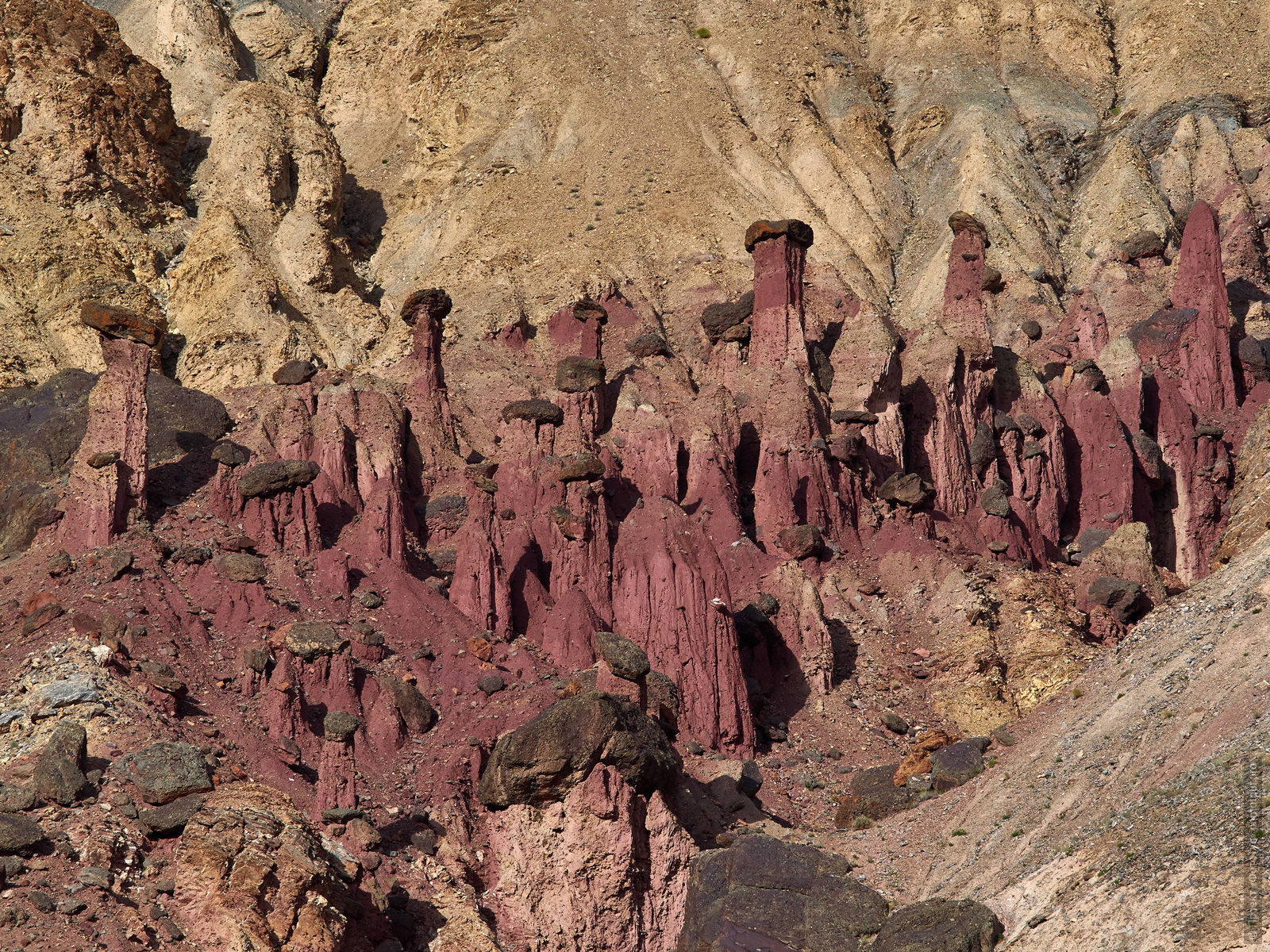
On the Bordovy Gorge we go down to the valley of the Indus and return to Leh.
Hotel in Leh.
Day 8, July 26: Leh. Free day. The old city, the height of 3 600 m.
Today is a day off, a day off:
We need a pause after our eventful trip - the first part of the Ladakh Adventure is over.
By the way, it will seem to many that it was not a week, but a whole life that has passed - Time in Ladakh flows according to its laws.
You can sit in Leh's cafes - freshly squeezed fresh, roast coffee, homemade cakes and pies,
You can stroll through the streets of Old Leh, this area is under the protection of UNESCO, here everything is preserved as 400 to 600 years ago, many houses can enter and meet a lot of amazing things.
For example, here are such ancient Tibetan amulets guards on the walls of the dwellings.

Hotel in Leh.
The second part of the Ladakh Adventure: Aryan Women. Source of Women's Power.
Day 9, July 27: Leh - Monastery of Djulichen - village of Domkar, Da Hanu, 158 km.
The heights of the day: Leh (3,600 m) - Djulichen (3,400 m) - Domkar (3,000 m).
And today begins the second part of our Ladakh adventure: Aryan Women.
Yes, we are going to a very unusual part of Ladakh - to the Aryans.
The Da Khanu gorge was opened for tourists only recently, in 2010, and some villages and much later, for example, Khan Ekma - was opened to tourists only in 2013.
And yet these are those Tibetan lands, of which there are many rumors and legends.
It was in these villages that Hitler organized expeditions "for the Aryan blood".
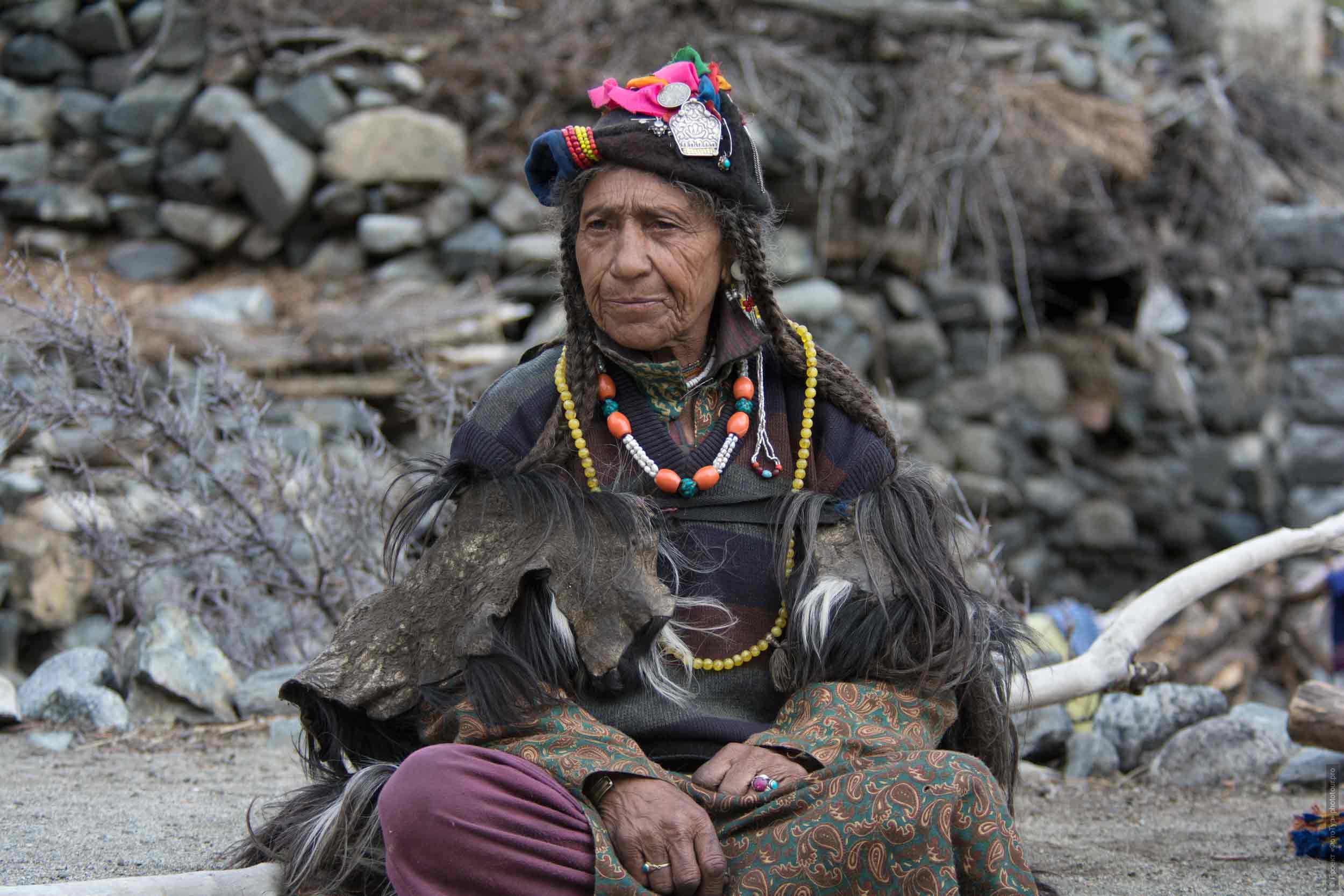
At present, there are two Dardish tribes in the territory of the former Ladak kingdom, who have retained their native language: the Dardas from the Dragon, and the Dardas from Da (Dha).
The first became Muslims in the 16th century.
The most interesting case is represented by darts from Da (Dha - Hanu).
They did not accept Muhammad's faith, but Buddhism was not fully accepted by them either - their religious practices more closely resemble the ancient pre-Buddhist religion of Bon.
Thanks to this, they were able to preserve their cultural uniqueness.
Their external dissimilarity and feature is not only in the form and features of the face, but also in the details of their ethnic clothing.
All men and women wear a headdress, the main ornament of which is the red flowers of the Physalis (wild strawberries), which protect them from demons and bring wealth.
In all forms of art, the symbols of the swastika and the sun are present in the drkpa: carved ornaments on houses, ornaments of antique utensils and household utensils.
There are also many natural and astronomical symbols.
Drkpa surprisingly combine mixed traditions with respect to food - they do not eat poultry meat and cows, but keep them for eggs and milk. Eat only lamb.
About 2,000 people remained in Ladakh of Aryans and live on the territory of five villages and only marry within their ethnic group.
Tourists in this area is very small, including because the tourism infrastructure is practically not developed.
But we go here to our friends - Sonam, a partner and co-founder of our travel company was born and raised in the Aryan village of Domkar.
This part of the tour is completely exclusive, no one else does anything of the kind, and Da Khanu gorge is stunningly beautiful:
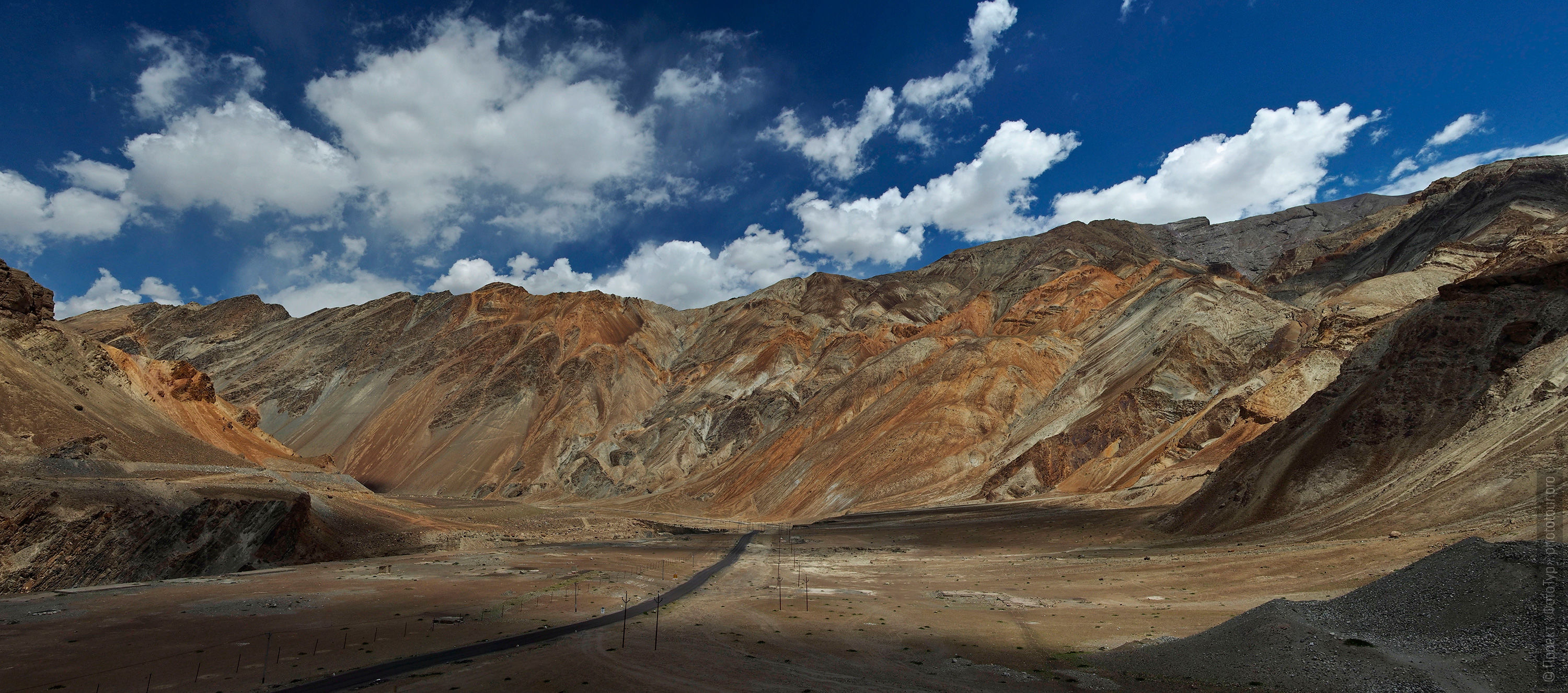
But before the Aryans we have to visit two more places:
1. Institute of Tibetan Astrology and Medicine Men-Ji-Khang in Leh.
There will be an opportunity to undergo pulse diagnostics from Tibetan doctors, if desired, to purchase Tibetan natural preparations, whose action is primarily aimed at eliminating the cause of energy imbalance in the body.
Also we will visit the museum of the Institute, here it is very interesting - ancient manuscripts, medical instruments, medical thangki and much more.
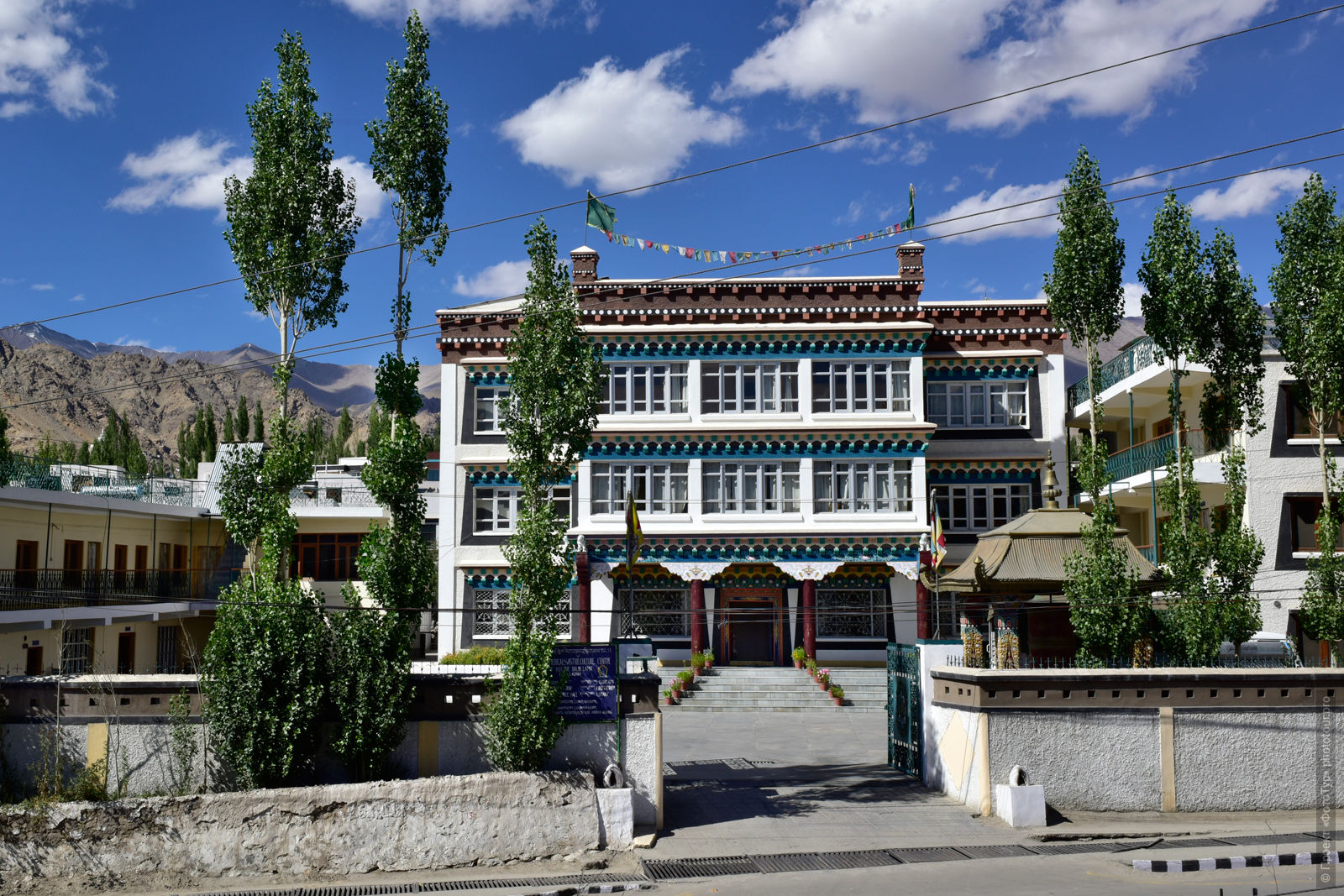
2. The female Buddhist monastery of Djulichen at the monastery of Ridzong Gonpa on the road to Da Khan, 73 km from Leh in the picturesque gorge.
Generally in Ladakh not many women's monasteries, and Julichen Gonpa and in general curious.
In Djulichen there are 26 nuns, their monastery is subject to Ridzong.
Radzong's administrative council tells the nuns what help Ridzonga and the nuns need. They work a lot.
Many old nuns are still working all day in the field, doing apricot oil, spinning, milking cows.
But young nuns, who are more educated, are allowed to devote themselves entirely to Buddhist philosophy and meditation.
If we are lucky, then we will get a female puja in the monastery.
In any case - this is a very beautiful and pretty place:
wander around the monastery, look at life, talk with nanari (the so-called Tibetan nuns) - always curious.
And further we will continue our way to the beautiful gorge of Ladakh - Da Khan.
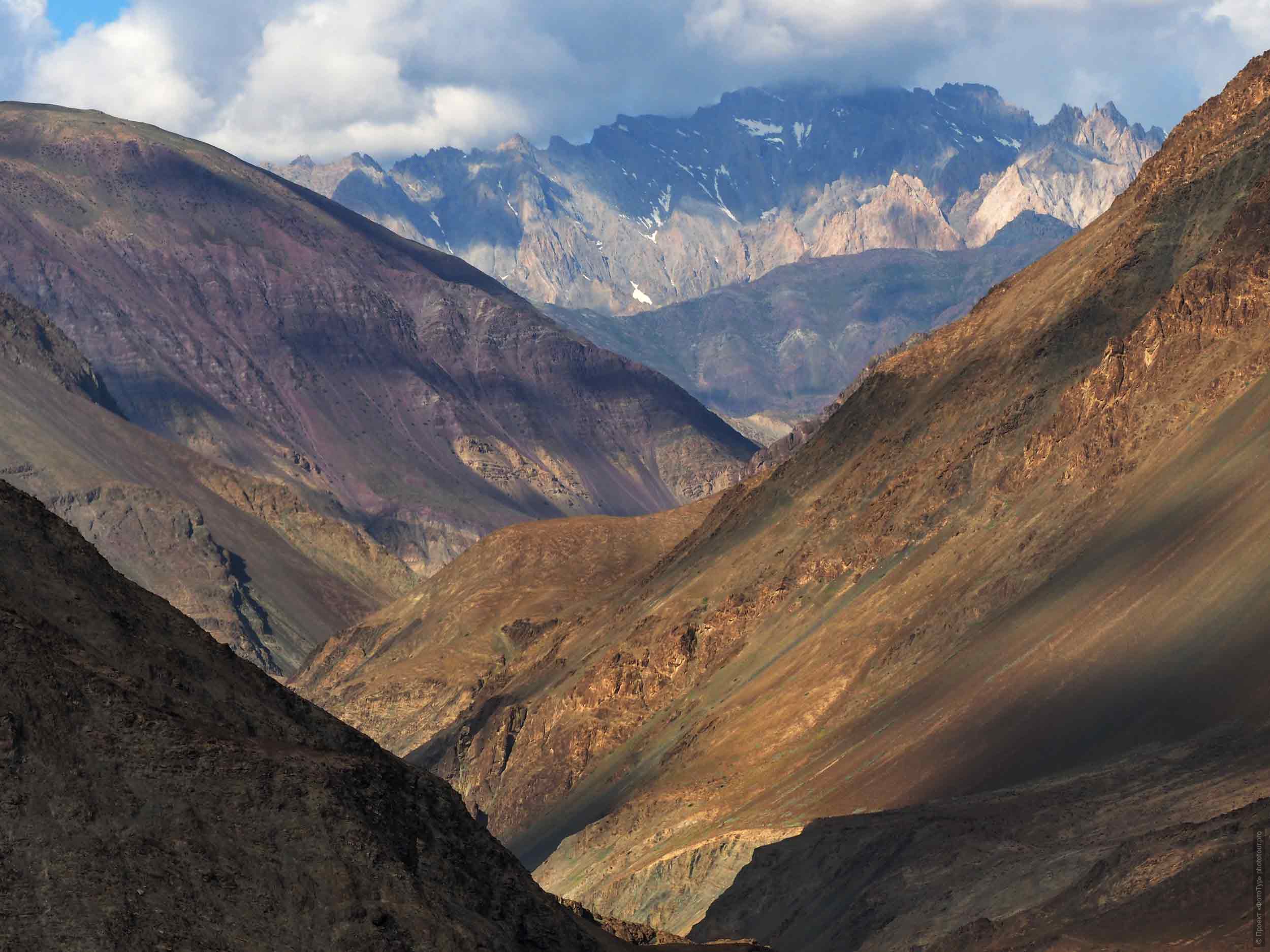
In the evening we arrive in the village of Domkar, we settle in a new guest house, dinner.
Guest house in the village of Domkar.
Day 10, July 28: The village of Domkar. The basics of Tibetan cuisine + picnic with local women. Walks through the village.
The height is 3 000 m.
We will spend the next two days in the village of Domkar, and these will be absolutely unusual days.
In the morning we will go for a walk around the village - a very old village, more than 400 years old and preserved in its original form, new buildings here fit into vacant spaces.
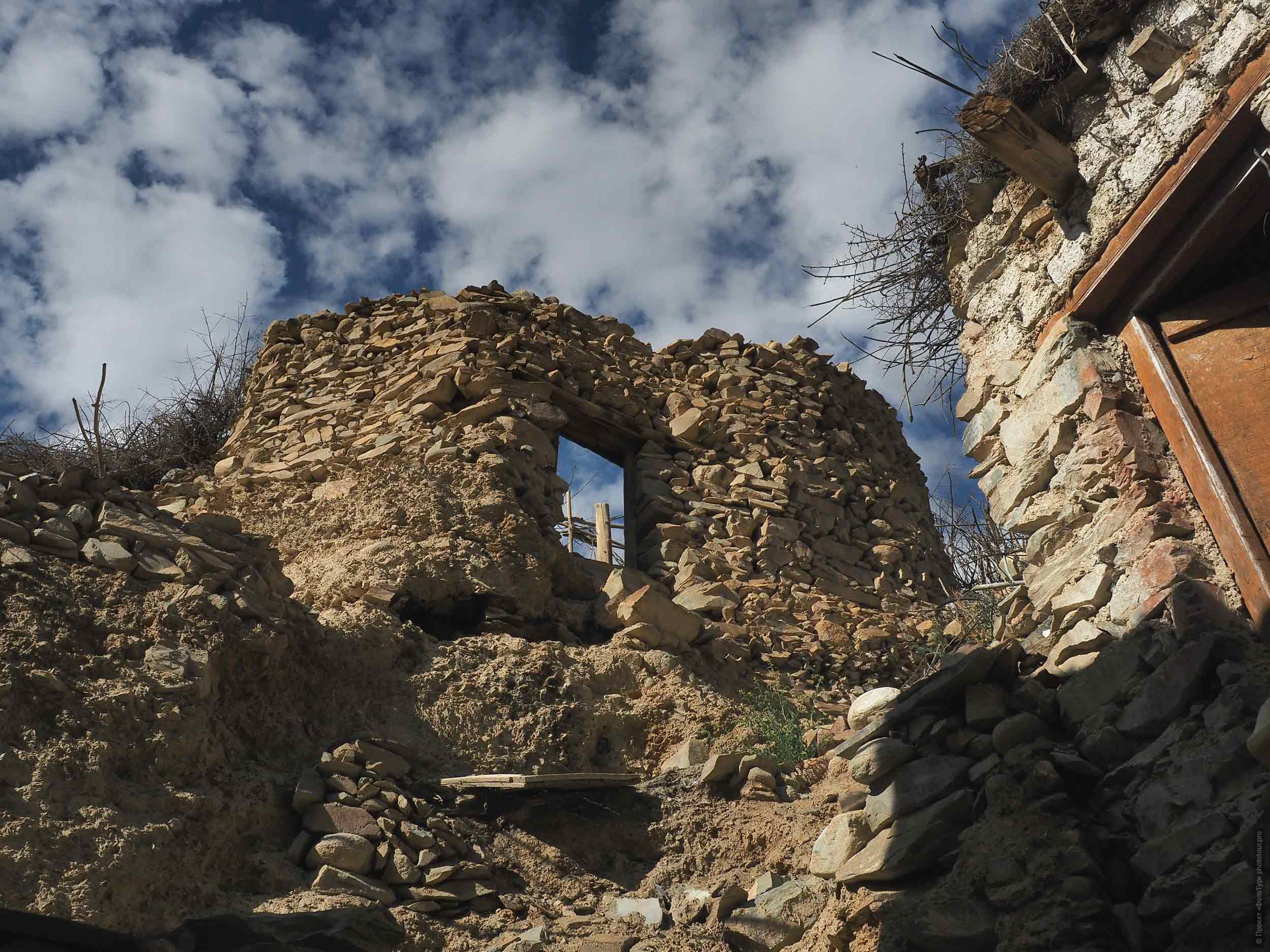
Old houses, abandoned do not break and do not rebuild.
Moreover, inside the old houses everything was preserved as during the life of the owners - and even the ancient pagan altars.
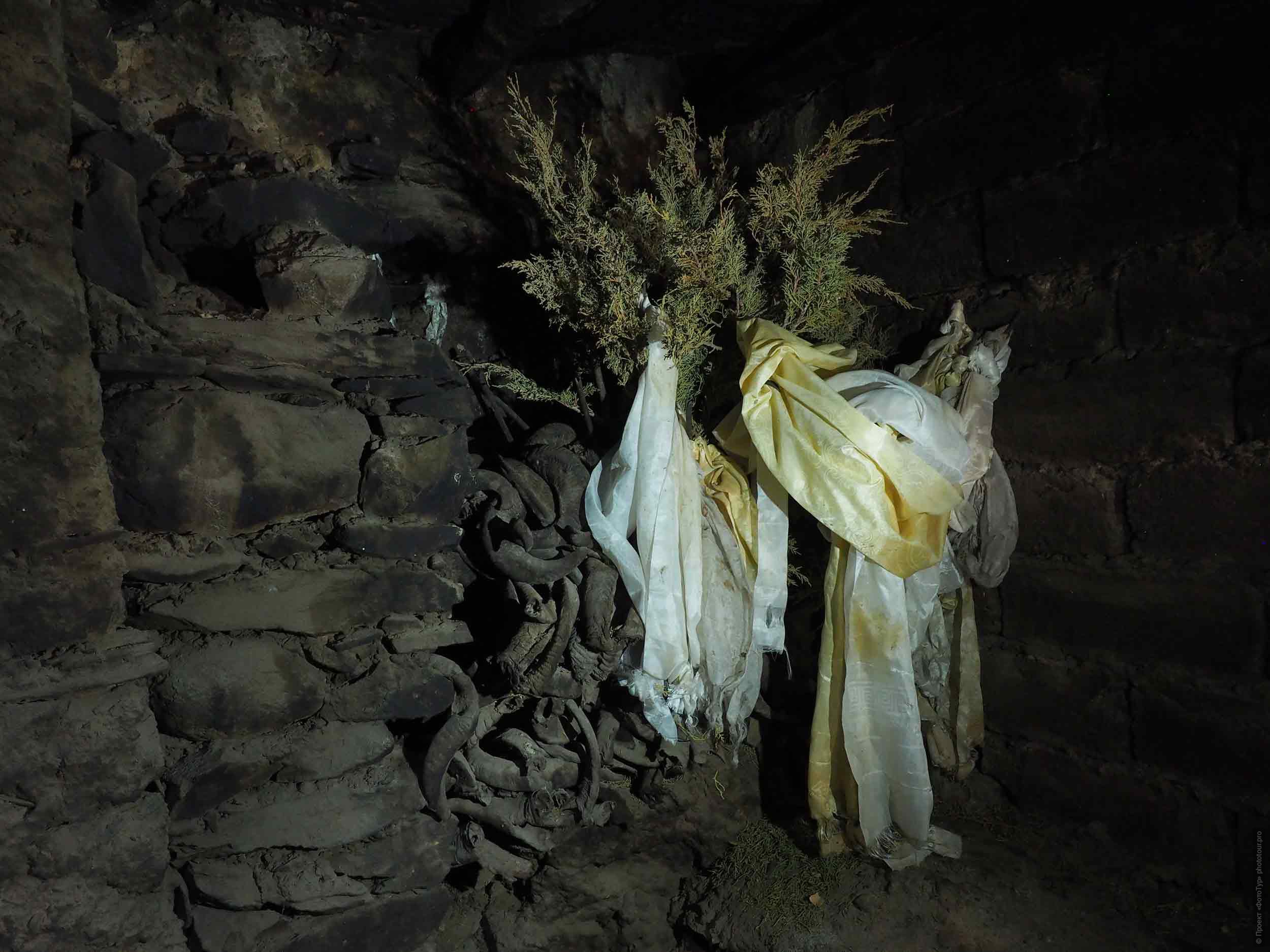
Interiors of such houses are amazing.
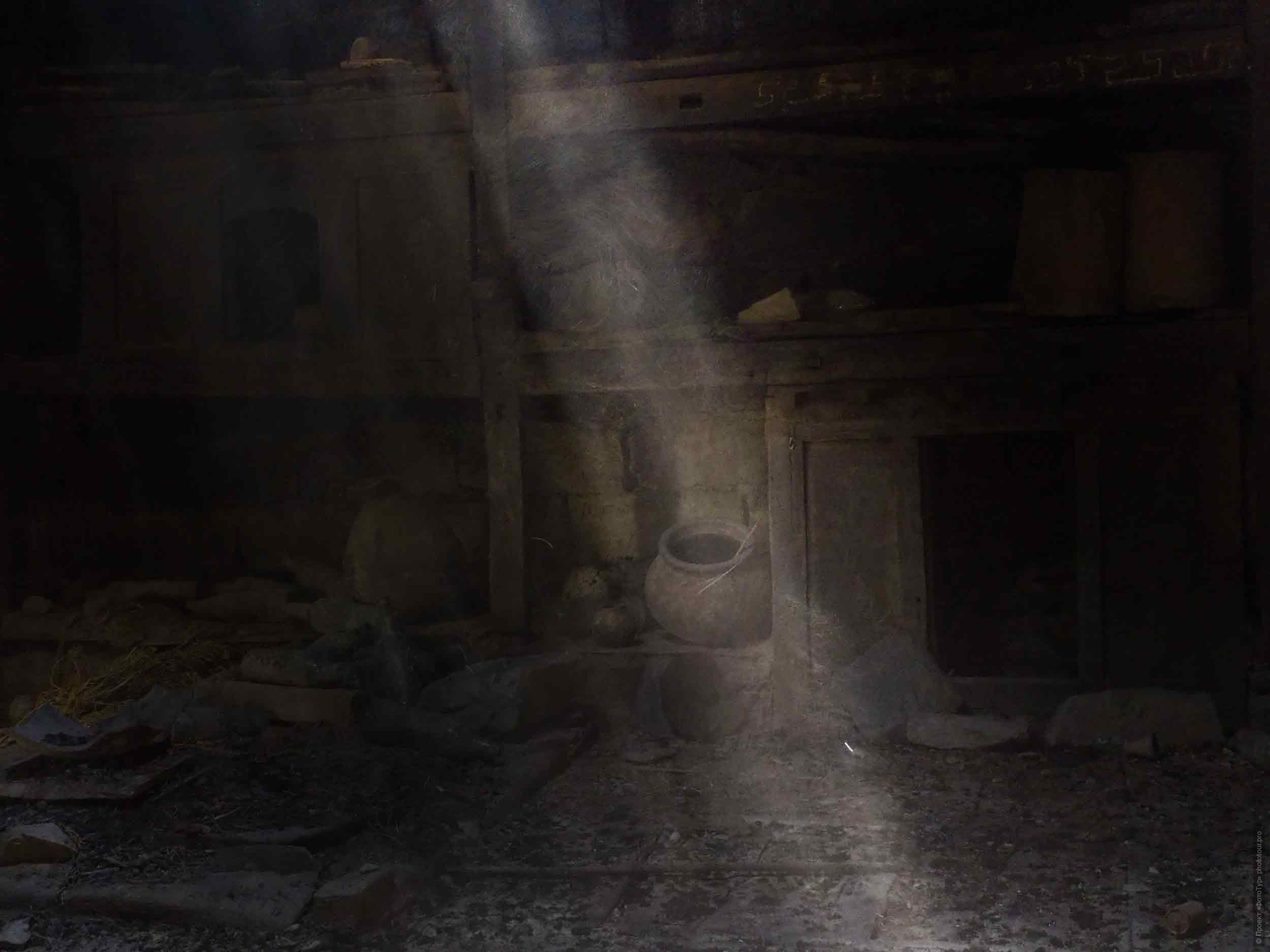
Visit to the local little village gong, puja for our group.
For a while we will disperse - someone much more like it, the village is small.
The doors of all houses for us will be open, you can go to almost any house, we will be happy - local ladies love guests.
At 14.00 we meet at the house of Sonama's mother, and here we will begin a practical master class on cooking dishes of Tibetan cuisine.
Kakar will talk about the basic principles of Tibetan cuisine and together we will prepare a large number of dishes for an evening picnic.
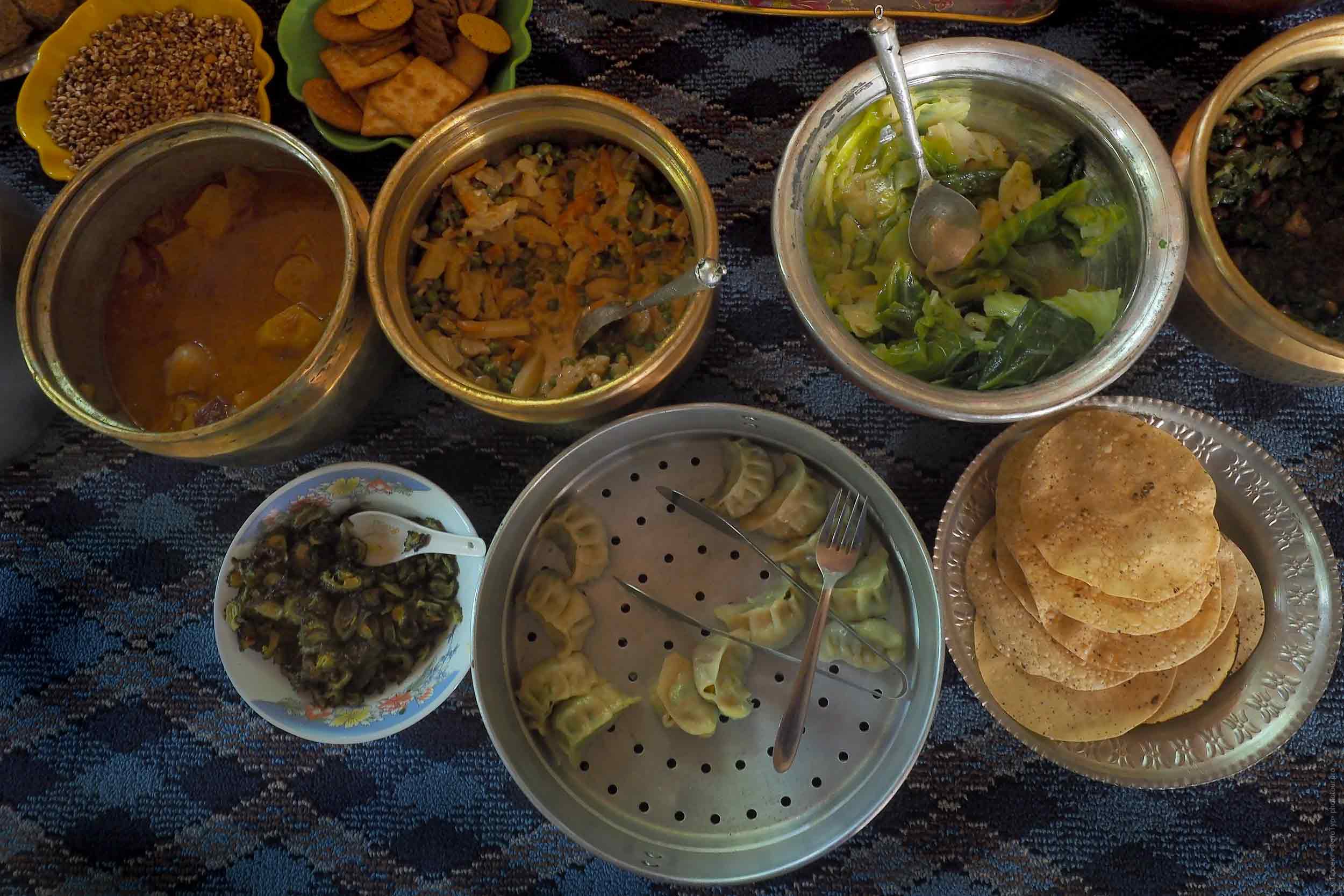
And in the evening - Picnic on the river bank in tents with local young ladies.
It will be delicious, fun and interesting.
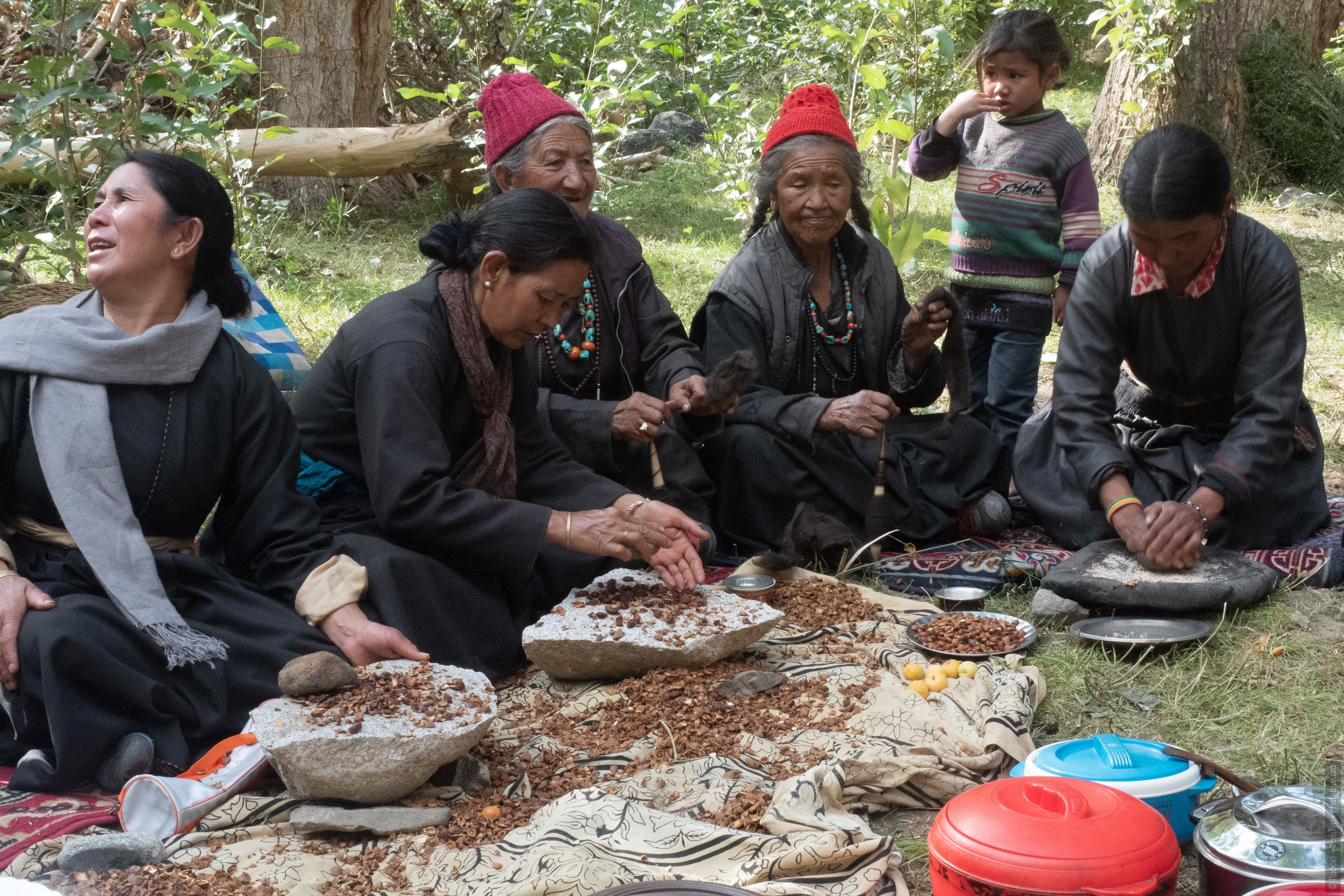
Here - how it will go, but usually it is very dynamic, and without song-dancing, testing of chang has never been done.
Let this part be some surprise.
Hotel in the village of Domkar.
Day 11, July 29: Domkar village: one day of the Aryan woman. Tibetan clothes and ornaments.
The height is 3 000 m.
Today's day consists of two parts:
1. In the morning we will go to learn about the real life of Aryan women:
each of the participants of the tour will be "distributed" into a separate Aryan family and spend all the morning in the works, cares and simple affairs of the mistress of the house.
Everyone will do it together.
If you want, you can go to the house in advance - from the night, spend the night in an Aryan house, climb up with the owners and live a real local day.
This is a very curious experiment, and, most importantly, you begin to understand what it means to be an Aryan.
2. In the afternoon, a master class on Tibetan women's clothing and ornaments.
Again, a solid practice:
Kakar will tell you about Tibetan clothes - how, why, why this, about the symbolism and everyday importance of Tibetan jewelry.
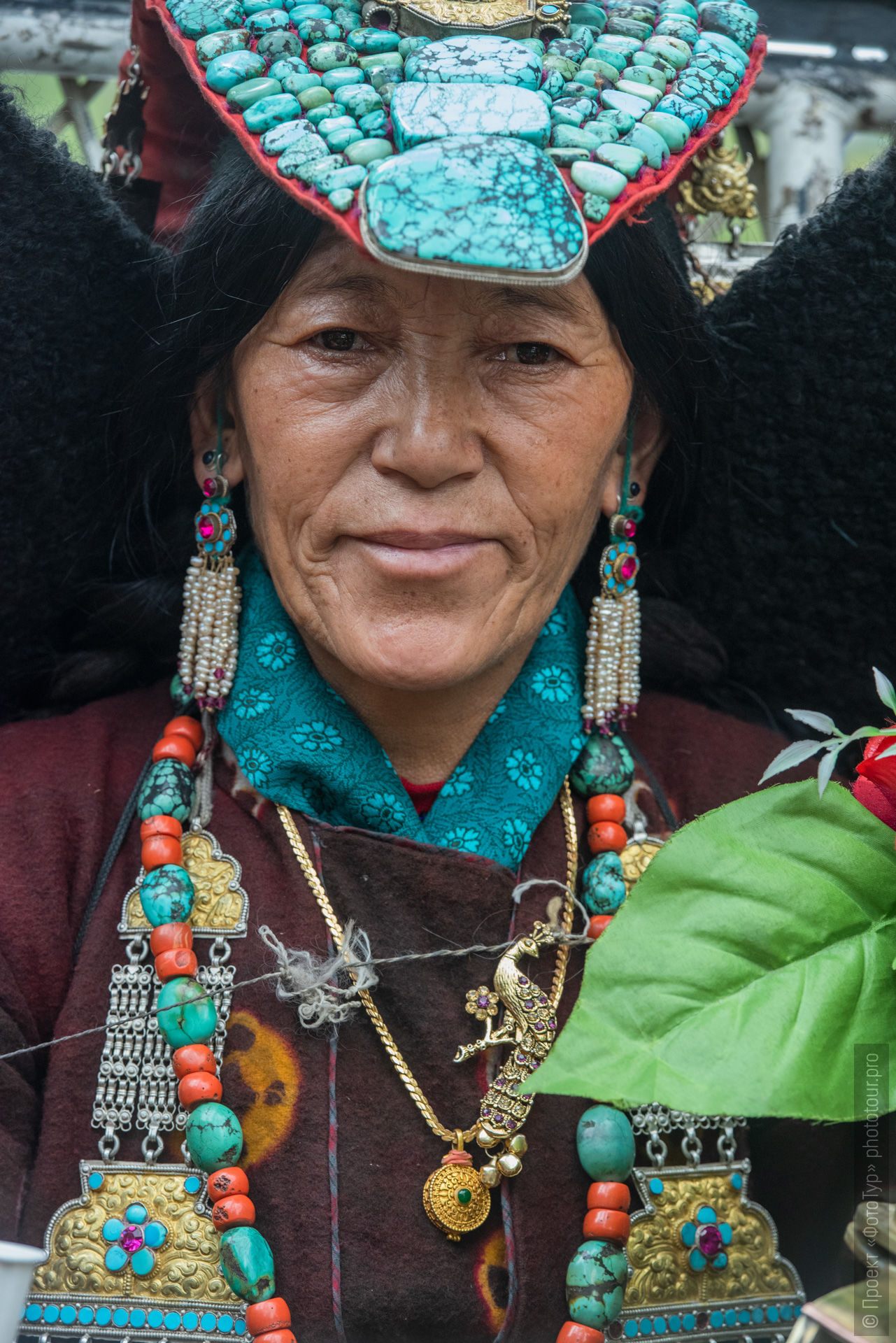
And then we move on to the practical part:
each of the participants will have the opportunity, under the guidance of the young ladies of the village, to dress for themselves the full national costume of a Tibetan woman.
And here, too, a pleasant surprise - now from Ilona Kryzhanovskaya:
each participant of the tour will receive a portrait in national clothes in the interior of a Tibetan house.
This is how - with this composition, we conducted a master class on Tibetan women's clothing in 2017:
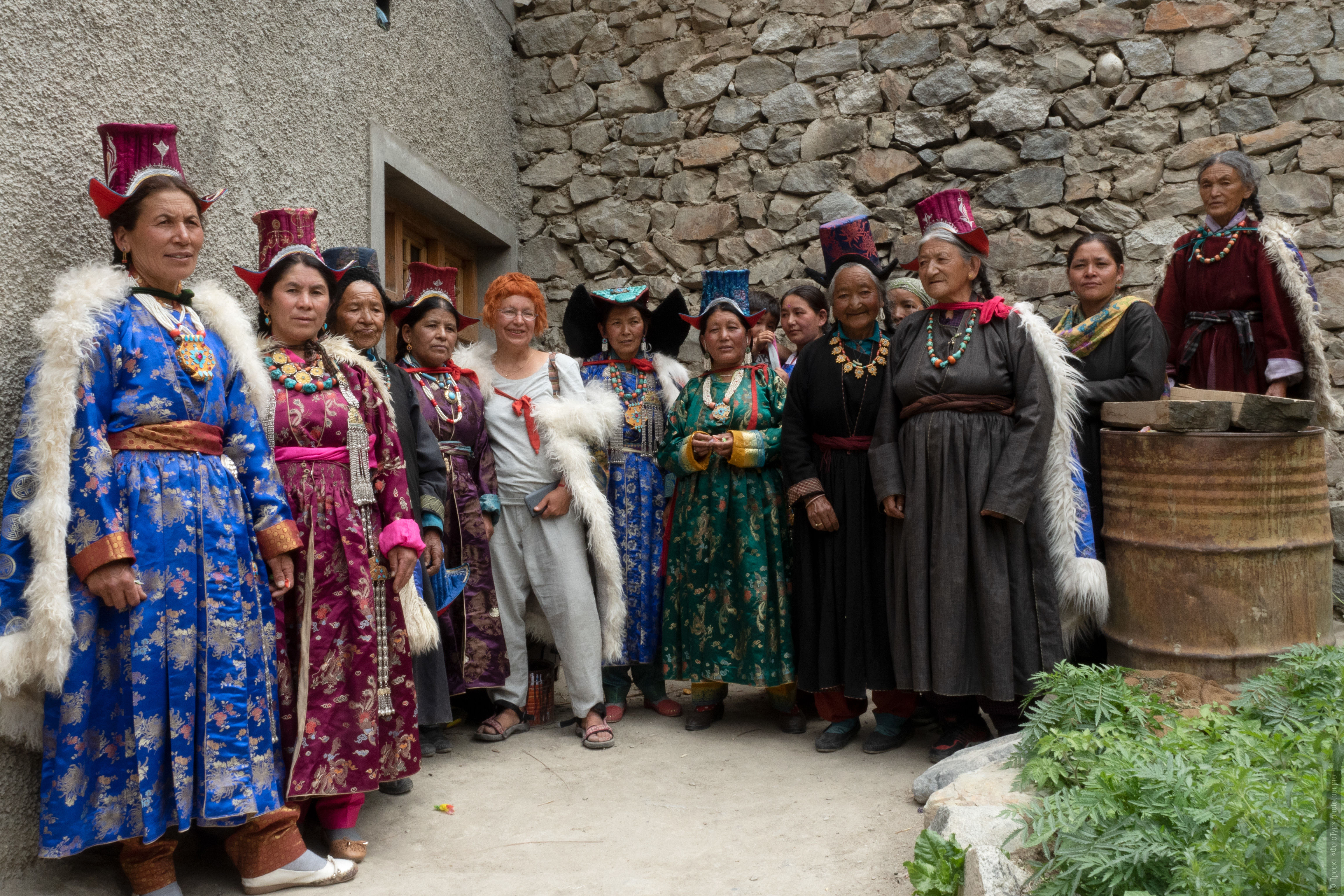
If on this day we have free time, we will spend it in walks through the village and gardens, located along a clean mountain river with very tasty water.
Hotel in the village of Domkar.
Day 12, July 30: Village of Domkar - the village of Hanu Ekma - Leh, 250 km.
The heights of the day: Domkar (3,000 m) - Khan Yekma (4,000 m) - Leh (3,600 m).
Early in the morning we leave the hospitable village of Donkar.
Today we will visit the oldest village of the Da Khanu gorge - Khan Yekmu - pay attention - how the houses fit into the mountainside.
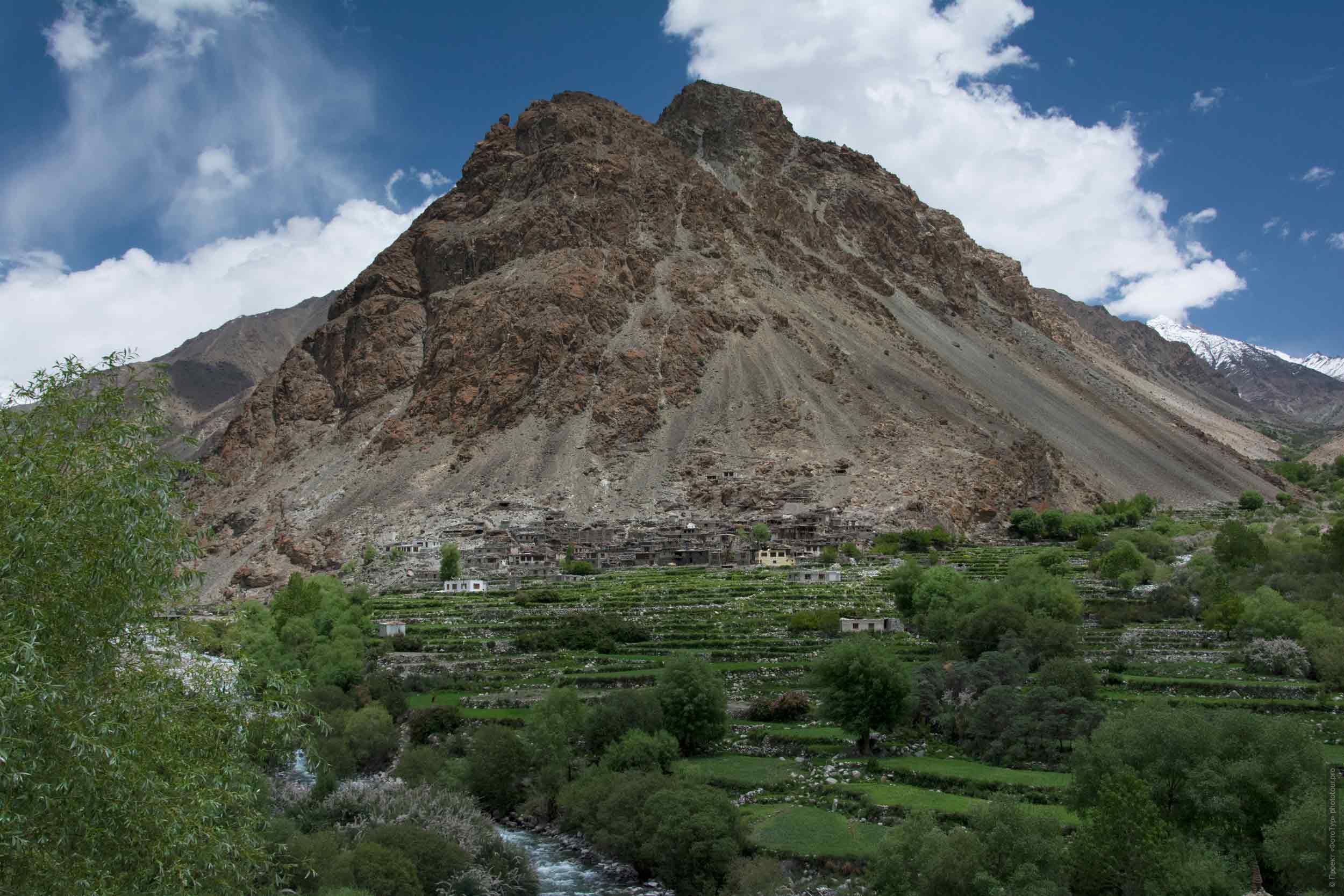
It is a very old village and is located in the immediate vicinity of the Pakistani border. The village is unique:
all houses are made of river pebbles, without a single gram of cement, clay, nails, etc.
Pebble boulders were not sharpened, but simply very precisely fit into the walls - this is an incredible piece of jewelry.
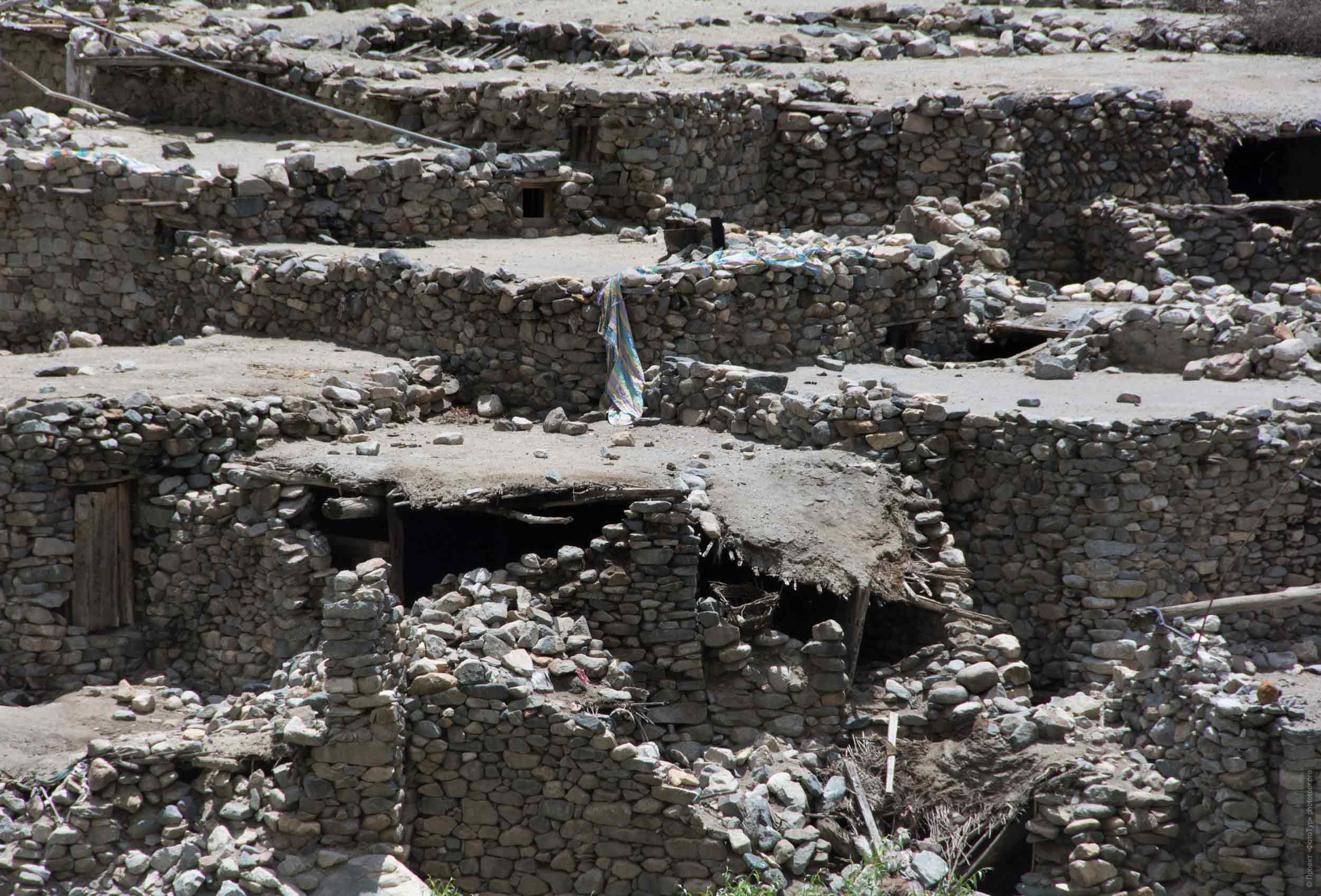
And these houses are already unchanged for more than 400 years.
We will spend about several hours in the countryside:
a visit to the local school, the stone houses of the village, which are made up of accurately tailored river stones without the use of a cementing mass, is truly a miracle.
Also we will visit the local small monastery and visit the houses of local residents, we will observe all the stages of hand weaving of canvas fabrics - in Khan-Yekma it was preserved in its original form.
In the afternoon we leave for the return journey to Leh.
Hotel in Leh.
Day 13, July 31: Buddhist mystery Dak-Tok Tsechu, Dak-Tok monastery. White Stupa of Naropa, 100 km.
The heights of the day: Leh (3,600 m) - Duck Tok (3,800 m).
Today is the final day of the tour, and we will spend this day on the Buddhist mystery of DakTok Tsechu at the Buddhist monastery of DakTok (Tuktuk).
DakTok Gonpa is the only Buddhist monastery of the Nigmapa school in the Ladakh valley.
Yes, the very Buddhist mystery with the performance of the Tsam Dance is a powerful and unforgettable energy performance, but there is one more thing:
all mysteries are very different.
And what we will see here is a completely different action than what we saw in the mystery of Karzok Gustor.
This is the special charm of the Buddhist mysteries of Ladakh:
they are real, and they do not follow the scenario, but are very much adapted to the laws of the universe, the astrological calendar.
Dance Tsam is always a very beautiful event filled with emotions and sensations.
But when the Deer enters the site of the Dak-Tok monastery - Time stops.
However, not only time stops, everything stops:
you stop noticing anyone around, stop breathing, stop feeling the world around you - there's only a deer dancing an unimaginable Something.
And this Something opens its wings above the earth and comes Silence, in which new worlds are born.
And this is impossible to convey in words.
All the conversations on the court stop, everyone is frozen in this Deer Dance, tears flow down the cheeks of people.
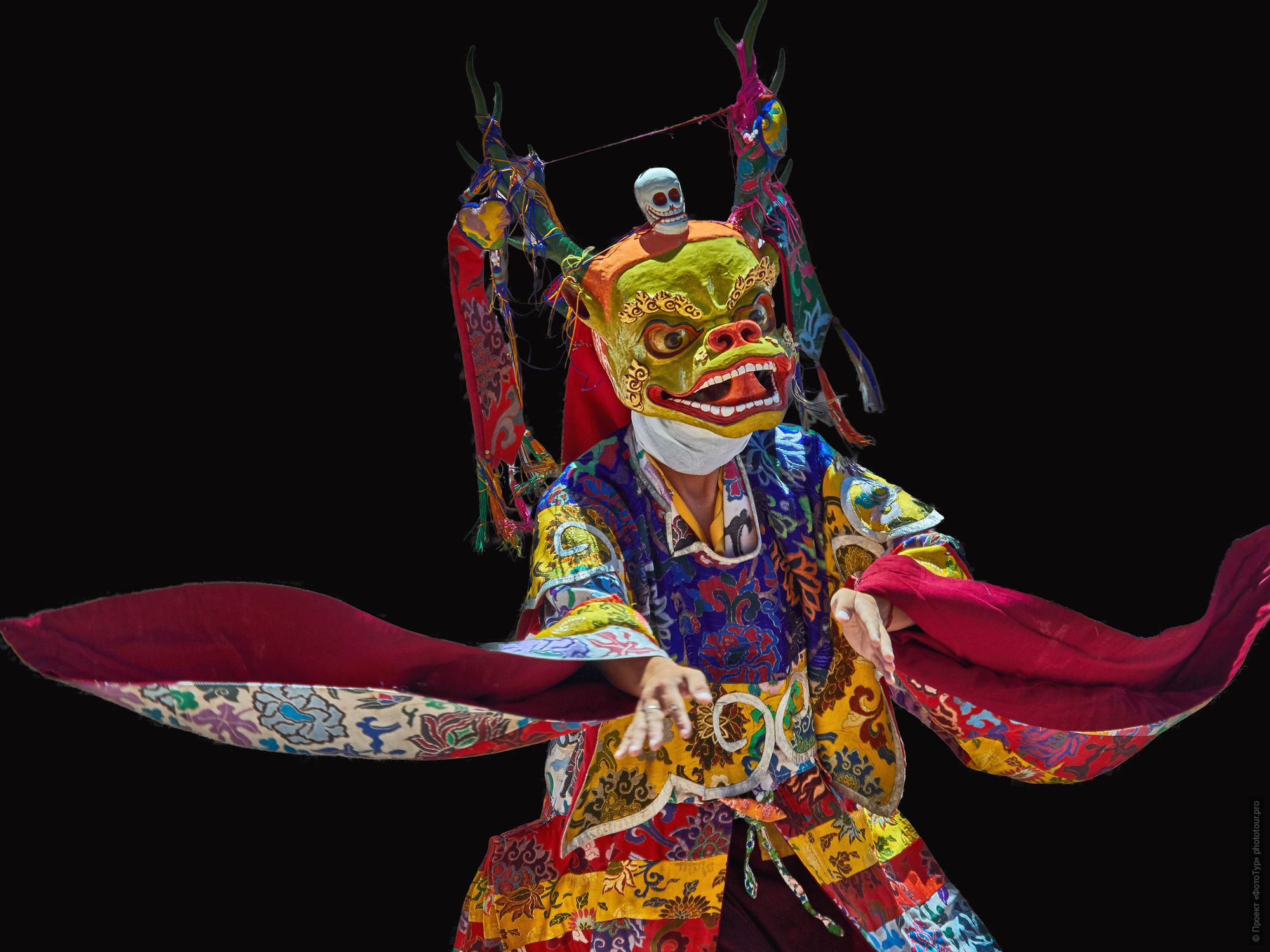
In the evening on the way back to Leh, we stop near the White Stupes of the Teacher Naropa.
This is a very unusual territory - a lot of white Buddhist stupas are scattered in an unobvious manner over an area of about 7 square kilometers,
stupas are very different - both in shape and size, different in sensations.

There is no regularity in the location of stupas in space.
But all together the White Stupas create the effect of the stopped Time:
when you enter the territory of stupas, then Time really ceases to be felt.
We wander among the White Stupas, wander around and walk.
Here we will find the sunset of our final day of the tour of Ladakh.
Hotel in Leh.
Day 14, August 1: Leh-Delhi flight. Homecoming.
Early in the morning - transfer to Leh airport, and Leh - Delhi flight.
And again the plane will float above the ancient Tibetan books of the Ladakh mountains.
And, let's hope that this time you will easily read open books of Ladakh.
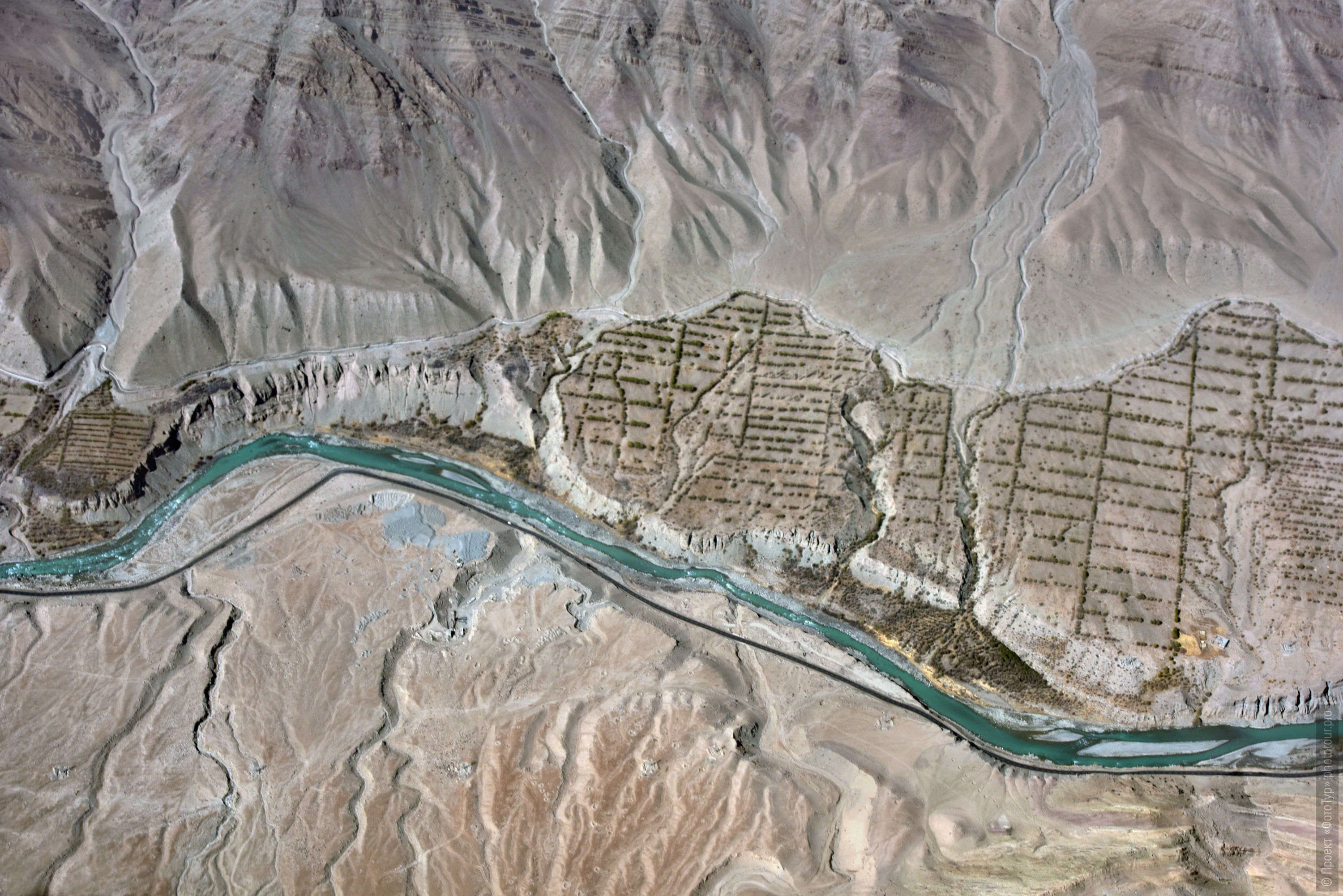
We remind you:
places near the windows in the plane is better booked in advance and - the mountains will follow you to smoke and curly clouds).
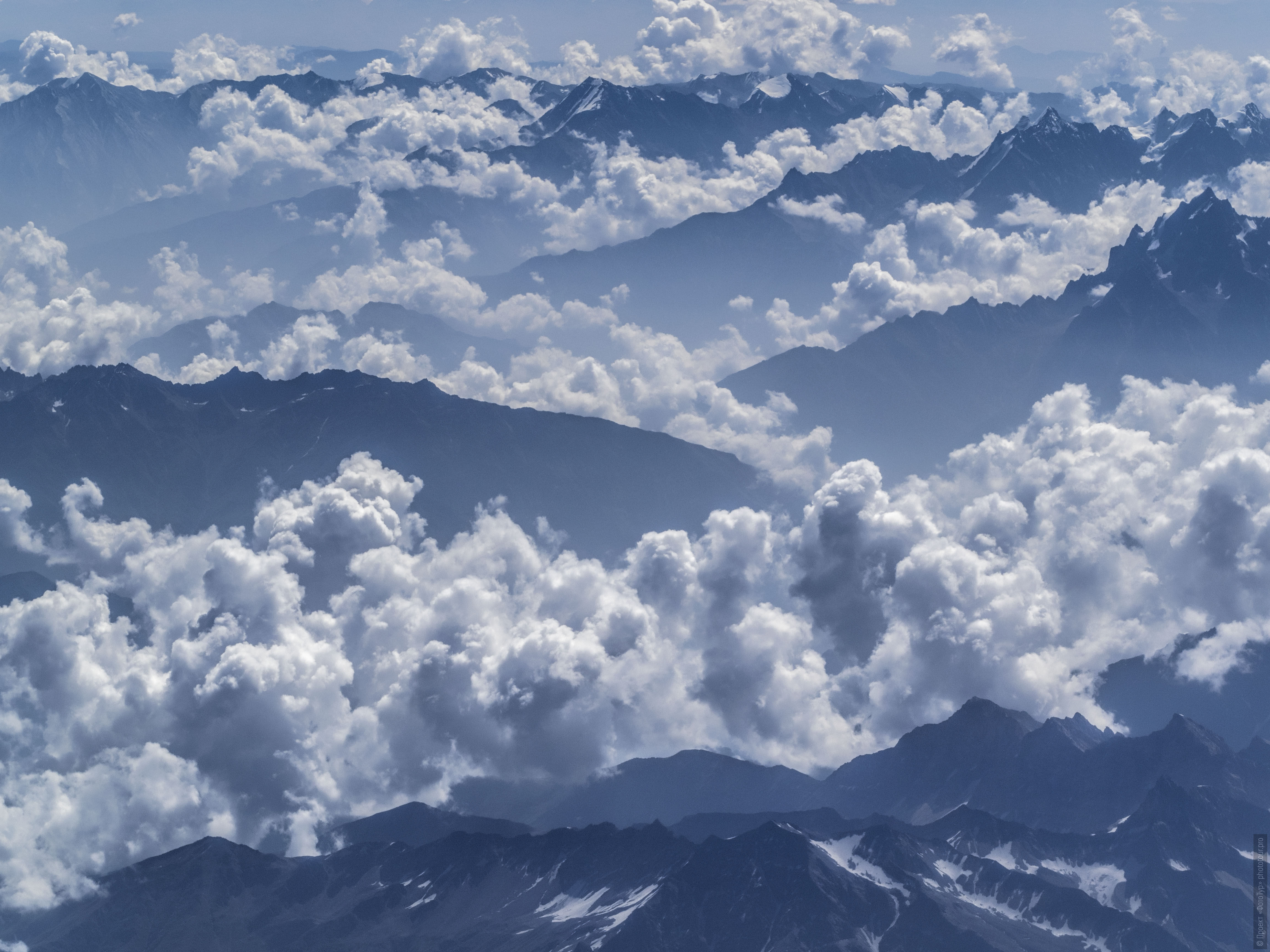
Upon arrival in Delhi, a tour of the Indian capital with guides is possible and upon prior request.
